Visiting Alcatraz and want to enjoy a pleasant hike? I recommend the Agave Trail!
Managed by the National Park Service, Alcatraz is a nature destination in its own right with plenty of trails, flowers, fauna, and scenery.
Sure, most people visit Alcatraz for the history — the prison, the Native American occupation, the numerous failed escape attempts. But I’ve lived in the SF Bay Area for over 20 years, and believe me, heading straight up the hill to the cellhouse, camera and audio guide in hand, will make you miss what many consider to be the island’s best-kept secret.
When I visit the Rock, I like to hike the various trails that offer gorgeous views along with an opportunity to see birds and wildlife. The most famous of these is the Agave Trail. Here, you can take a break from the crowds that dominate the prison area and enjoy unspoiled natural beauty on this gorgeous island park.
Among the many things to do on Alcatraz Island, the Agave Trail is certainly the path less-traveled, but that just makes it all the better. Here are my tips for hiking the Agave Trail on Alcatraz Island.
When to hike the Agave Trail on Alcatraz

Unfortunately for summer tourists, the trail closes every year during peak bird nesting season, which is February through September. This is to protect the island’s important bird populations that nest on the rocky shores, including cormorants, pigeon guillemots, and black-crowned night herons.
If you’re planning a visit specifically to hike the Agave Trail, aim for October or November. You’ll avoid the summer fog and the heaviest summer tourist travel and catch some of our clearest days for photography. This time of year is also when you’re most likely to spot wildlife, which tends to be more sparse during the blaring heat of summer.
The Agave Trail tends to be open at other times of year outside summer. Still, a winter storm occasionally will cause a temporary closure, so check the NPS website if the forecast looks treacherous.
Best time of day for hiking on Alcatraz
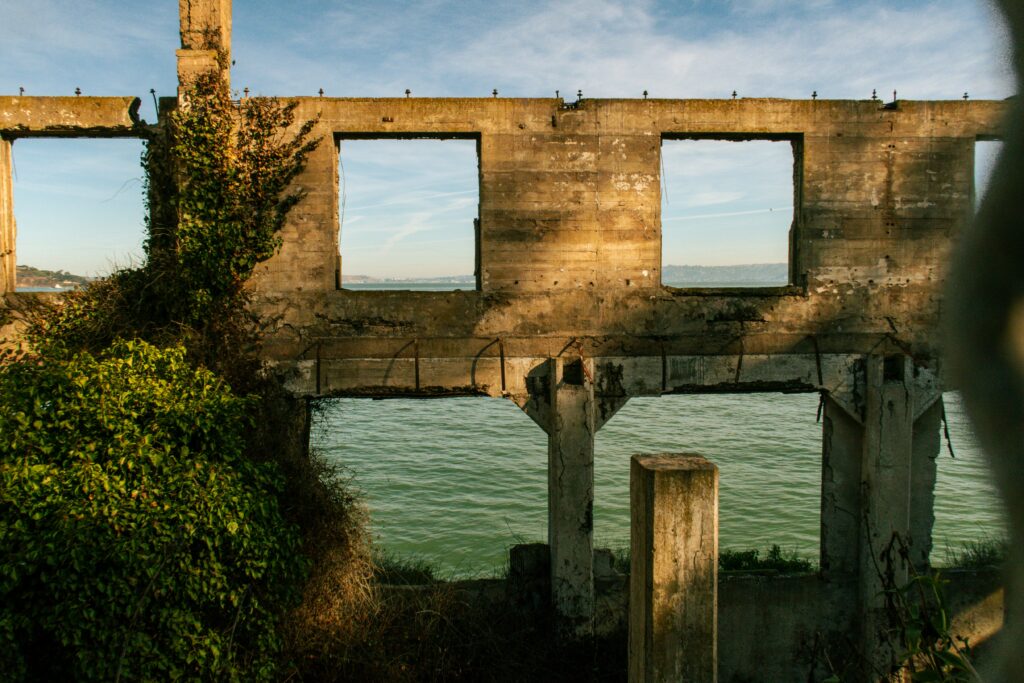
If your itinerary focuses primarily on getting the perfect shots or having the quietest, most peaceful experience, consider skipping the tourist-packed morning boats. The late afternoon ferries are less crowded, and the afternoon light on the western exposure of Alcatraz makes for better photos anyway.
Taking one of the later ferries (around 2-3 p.m.) still gives you plenty of time to explore the Island before the last return ferry.
That said, if you want to see burrowing owls, deer mice, or any other wild inhabitants on the island, it’s best to get the first ferry possible in the morning (usually around 9 a.m.), when they’re most active.
Where to find the Agave Trail
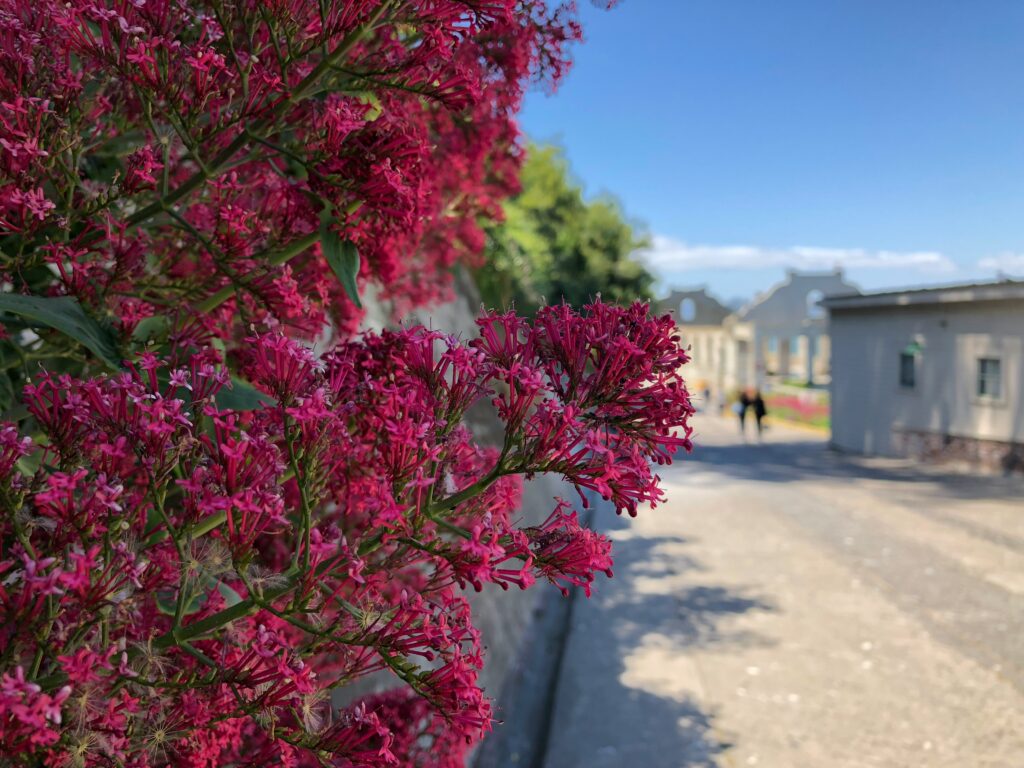
You’ll start your hike just south of the dock where the ferry lands, beginning on a stone-lined path that goes through a grove of eucalyptus before dropping down towards the water.
From here, on a clear day, you’re likely to get glimpses of sailboats, as well as the Bay Bridge and downtown.
As the trail curves around the island’s south side, you’ll pass the large sign you may have glimpsed from the ride over on the ferry: “persons procuring or concealing escape of prisoners are subject to prosecution and imprisonment.”
Just after that, you’ll come to a spot on the shore where the island’s rocky tide pools are exposed — at least, if you’re lucky, and it happens to be low tide. Tide pools are unusual in the San Francisco Bay. These are actually human artifacts, accidentally created from the rubble formed by years of blasting and building on the island.
From here, the Agave Trail heads uphill to the stone parade grounds, which were carved by prisoners in the 1870s. At one point, this area was surrounded by tiny homes for Alcatraz guards and their families. But these were demolished in 1971, leaving debris scattered across the concrete expanse.

Today, these rubble heaps shelter many creatures that call Alcatraz Island home: burrowing owls, night-crowned herons, Western gulls, salamanders, and deer mice (the only mammals still living on the island full-time). Birdwatching on Alcatraz Island is some of the best in the Bay Area, particularly on this quieter part of the island.
Your efforts to hike up the hill pay off, and you’re rewarded with beautiful views of Treasure Island, the Golden Gate Bridge, the Bay Bridge, and the steep green cliffs of the Marin Headlands (which always remind me a bit of Ireland).
At this point, you’ve reached the end of your moderate hike. You’ll head back the way you came — this is an out-and-back trail rather than a loop. The total distance is just 0.7 miles, about 20 minutes each way if you’re going at a leisurely pace.
Best views from Alcatraz
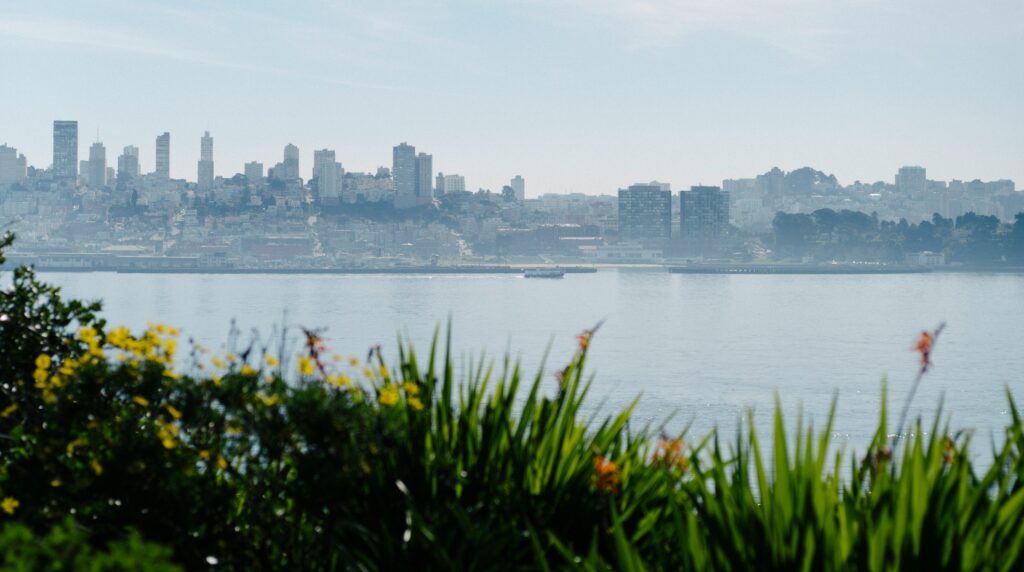
One thing that I love about hiking the Agave Trail is the special perspective of seeing the city from sea level — not the elevated views tourists get from Twin Peaks or Coit Tower. This vantage point helps you understand the desolation that prisoners (and sometimes the guards and their families) felt here and why the indigenous Miwok people called the island the “place of evil spirits.”
When the afternoon westerlies kick up, and waves crash against the rocks below you, it’s easy to feel the island’s isolation despite the city being tantalizingly close.
The island’s microclimate has created a surprising diversity of plant life along the trail. You can’t miss the massive agave plants that give the trail its name. They were planted by guards as a deterrent for would-be accomplices for escape attempts as well as for the alcohol you can make from them. You’ll also spot California poppies, wild radish, native grasses, and more. In winter months, you might catch migrating monarch butterflies taking shelter in the protected coves.
Alcatraz history for your hike
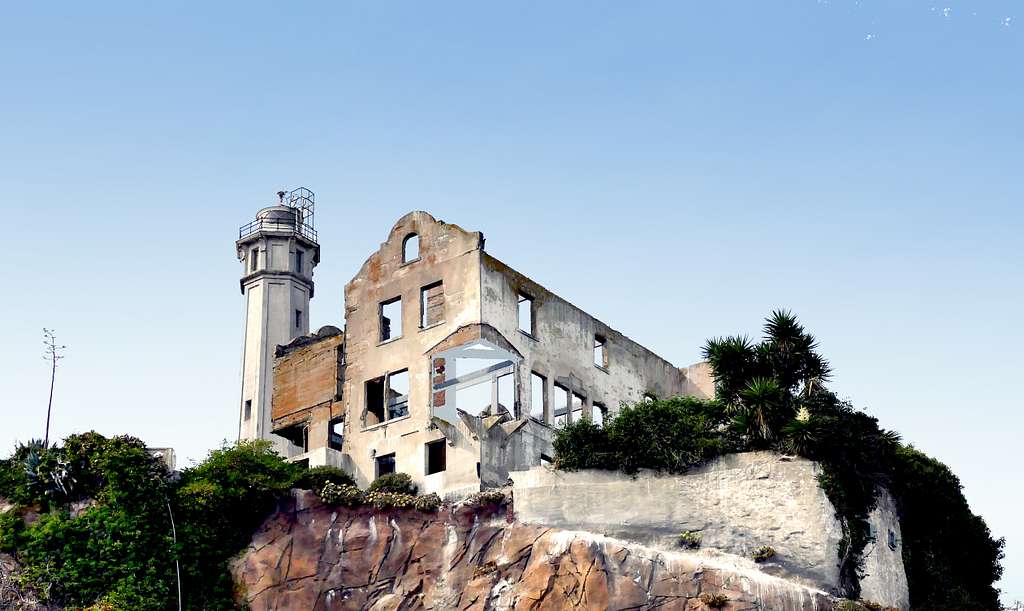
What I appreciate most about the Agave Trail is experiencing Alcatraz without someone talking in my ear. This path wasn’t just off-limits to the public during the prison years — it was part of the security perimeter where guards patrolled to prevent escapes.
When you walk it now, you’re literally following in the footsteps of guards who kept watch over some of America’s most notorious criminals. And you’re out of earshot of the crowds that tend to stick to the prison cells and dock area.
About halfway along, look up to see the prison buildings from angles most visitors miss. The perspective of the cellhouse from below gives you a much better sense of how it dominates the island. You’ll also spot the ruins of the warden’s house and, if you know where to look, remnants of the old military fortifications from when Alcatraz was a U.S. Army fortress before becoming a federal penitentiary.
The trail gives context to famous escape attempts, too. Standing there looking at the churning currents and feeling the frigid water temperature, you’ll understand why most escape attempts ended tragically. The infamous 1962 escape by Frank Morris and the Anlin brothers likely launched from somewhere near this trail — this may, in fact, be one of the few successful escapes since the men were never found, although they were assumed to have drowned.
Tips for hiking on Alcatraz
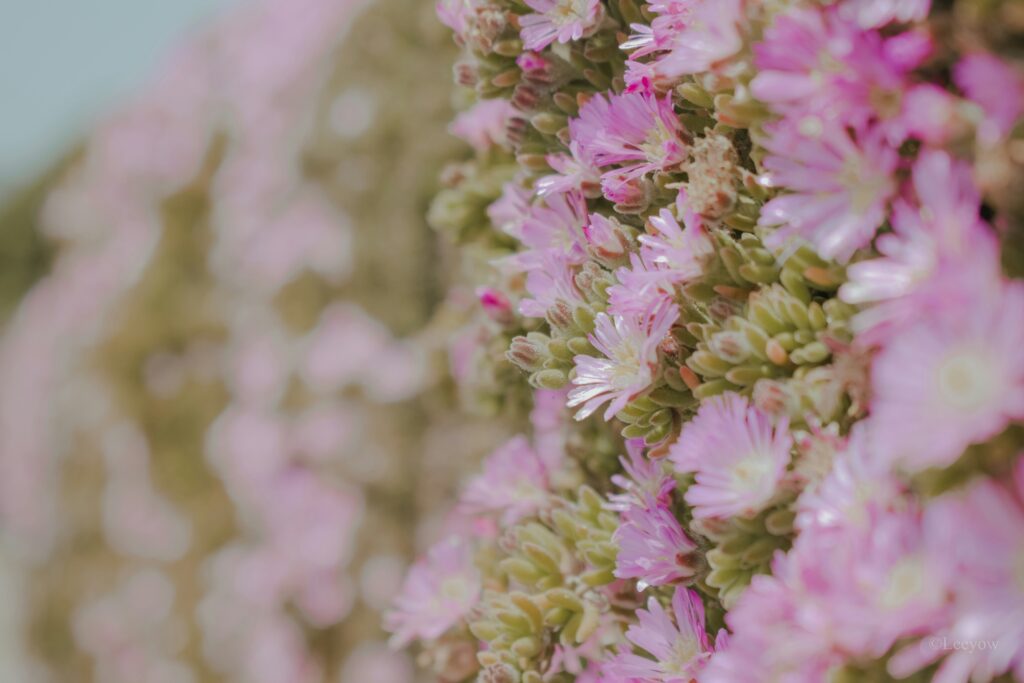
Here are some final tips for your trip if you want to enjoy a nature hike on Alcatraz.
Bring layers, even on sunny days. The microclimates on the island can be dramatically cooler than the mainland, and the wind chill factor can be intense. I promise you that the thin, touristy sweatshirt you bought at Pier 39 won’t cut it when the afternoon winds pick up. If you have a raincoat, it’ll help protect you from seaspray.
Pack your own water and snacks. There are concessions on the island, but they can be overpriced and not particularly good. If you want to make it a proper Bay Area experience, grab a sourdough sandwich from Acme Bread at the Ferry Building before boarding. After your hike, warm up with a bowl of clam chowder at Fisherman’s Wharf, which, even for a local, is an absolute must. It’s really, really good).
Remember that tickets to Alcatraz often sell out weeks in advance, even during the mild October and November months when there are fewer tourists. I’ve also been able to score tickets the day of, so never give up hope. But it’s best to book your Alcatraz tickets in advance to guarantee your spot.
Why you should hike the trails on Alcatraz
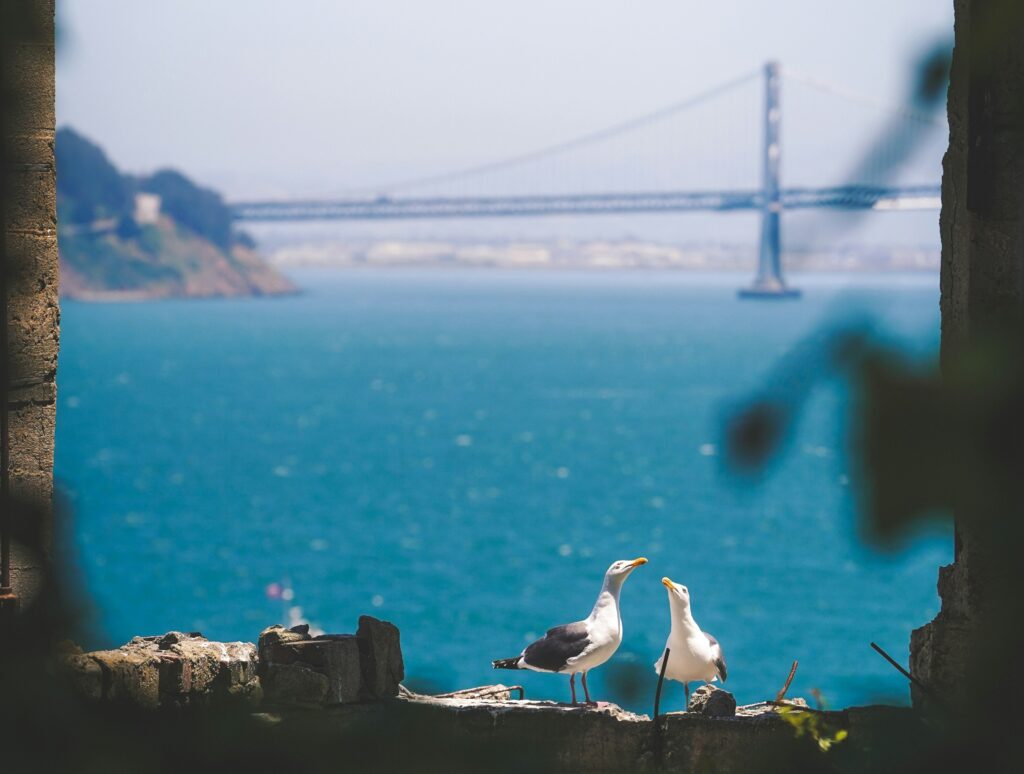
Hiking the Agave Trail lets you experience Alcatraz as part of the San Francisco Bay, not just as a tourist attraction. The constant soundtrack of waves against the rocks, the call of seabirds, and the distant hum of the city creates a more intimate experience of the island and its place within a larger ecological and human context, which is easily lost if all you visit is the crowded cellhouse with its tales of crime and punishment.
On windy days, which are frequent in the Bay Area, the salt spray hits your face as you round some corners of the trail. It’s a visceral reminder of the harsh natural forces that made this island such an effective prison and still an isolated habitat for birds and wildlife today.
I like to bring Alcatraz-sceptical visitors here to see how their understanding of Alcatraz transforms from a “tourist trap masquerading as a historical site” to a “harsh, beautiful, complex place” as we hike among agaves and sea anemones.
The Agave Trail is a beautiful example of Alcatraz’s ongoing transition from its harsh penitentiary past to its current role as a national park where history, culture, and nature intersect. It’s gone from prison to sanctuary, especially for wildlife, and nowhere is that more evident than on this often-missed bit of the island.
Looking for more nature to explore here? Check out my guide to the best Alcatraz Island gardens!
When you think about Alcatraz, sitting in the middle of the San Francisco Bay, you probably think about the iconic prison that housed some of the country’s most notorious prisoners. It stands out in every postcard, situated on top of a hill on this tiny 22-acre island.
But Alcatraz has many more buildings besides the cellhouse where prisoners lived. Some are accessible to the public. Others are in ruins, making for some atmospheric photos. In recent years, park officials have also restored several historic Alcatraz buildings, many of which have been damaged by salt air corrosion.
The buildings and other structures that stand today reflect the island’s history and its many lives as a fortress, military prison, federal penitentiary, protest site and a national park. You can learn more fascinating bits of Alcatraz’s storied past by visiting these dozen or so structures and ruins.
Here’s the complete list of the historic buildings you can see today on Alcatraz Island.
1. Cellhouse
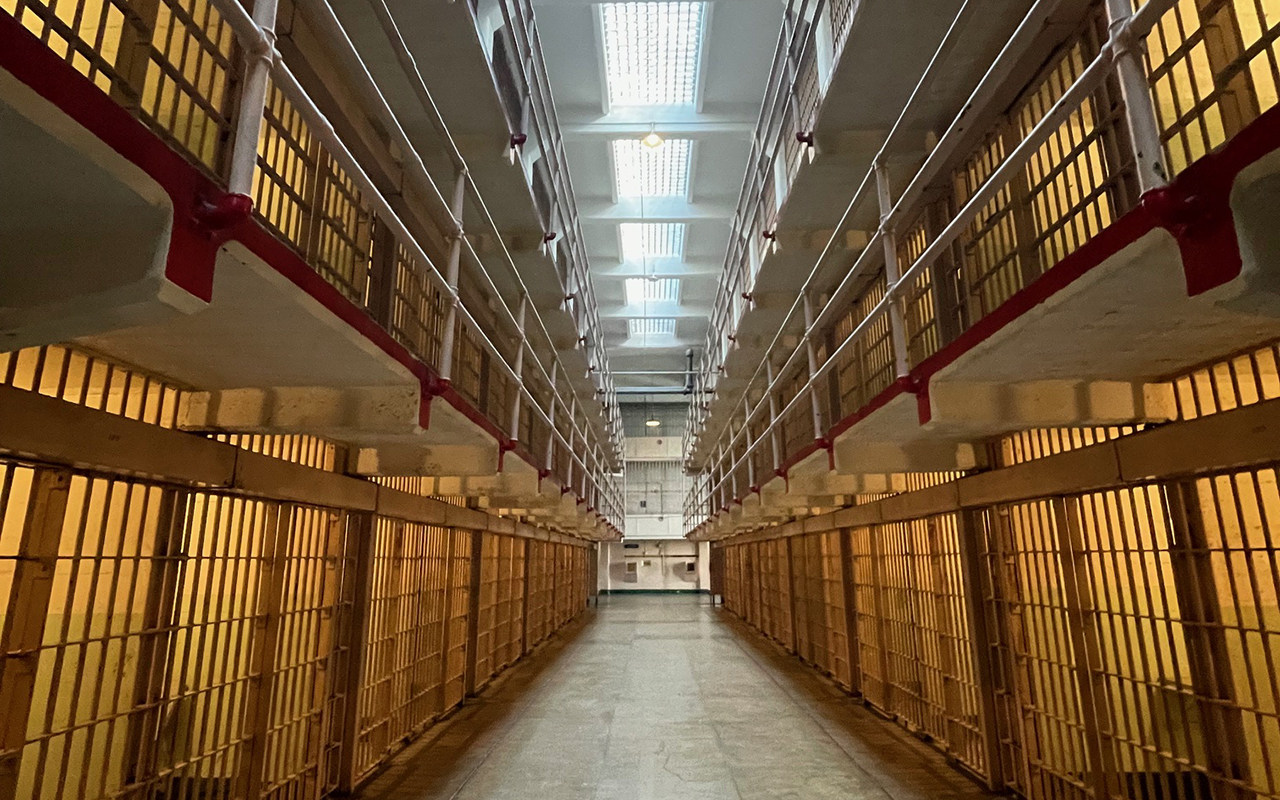 Credit: Marnette Federis
Credit: Marnette Federis
I’ve got to start this list with the infamous cellhouse that every tourist is keen to visit when they arrive on the island.
The reinforced concrete, three-story building you see today was created in 1912, built on top of what used to be the island’s fort. Construction on the building began in 1908 once the island became an official military prison. During that time, the facility saw anywhere between 200 to 600 prisoners.
When the prison was transferred to the Department of Justice, the building underwent remodeling to prepare for the incoming federal prisoners. The cellhouse consists of an administration wing, four cell blocks, a hospital wing and a dining room area. A recreation yard is attached to the cellhouse.
Pro tip: The best way to learn more and explore the cellhouse is through the park’s audio tour, including with your ticket to the island.
2. Guard Tower
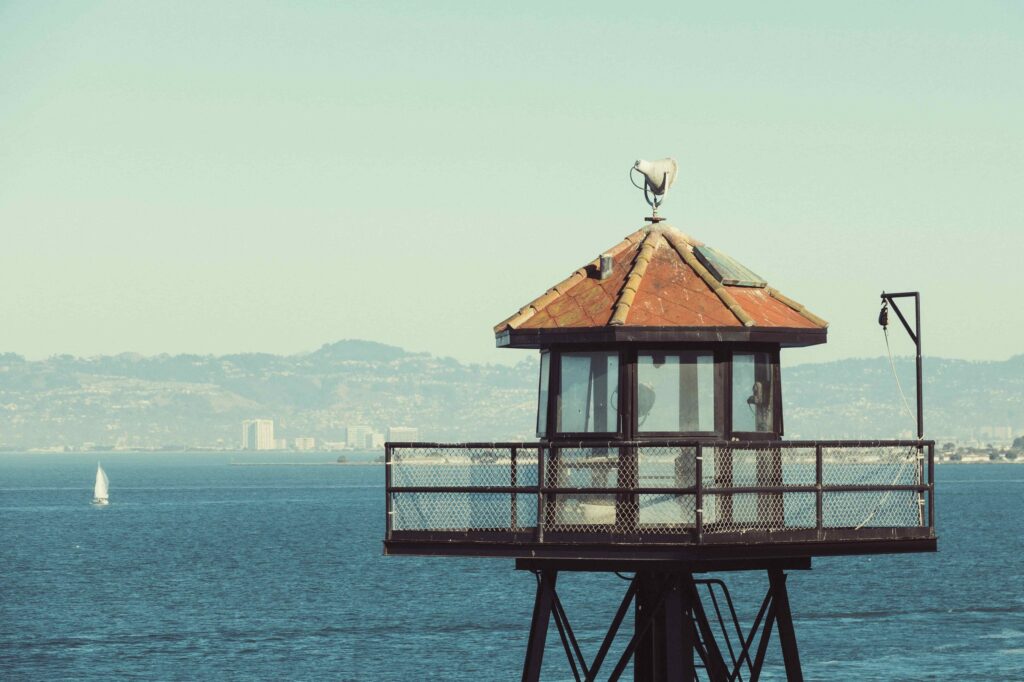
Guard towers and catwalks were built in the 1930s once Alcatraz started operating as a federal prison. One tower overlooking the island’s dock still stands today and is one of the first structures you’ll see when arriving at Alcatraz.
Fun fact: The dock guard tower was repaired and repainted in 2013 as part of a larger restoration effort.
3. The barracks aka Building 64
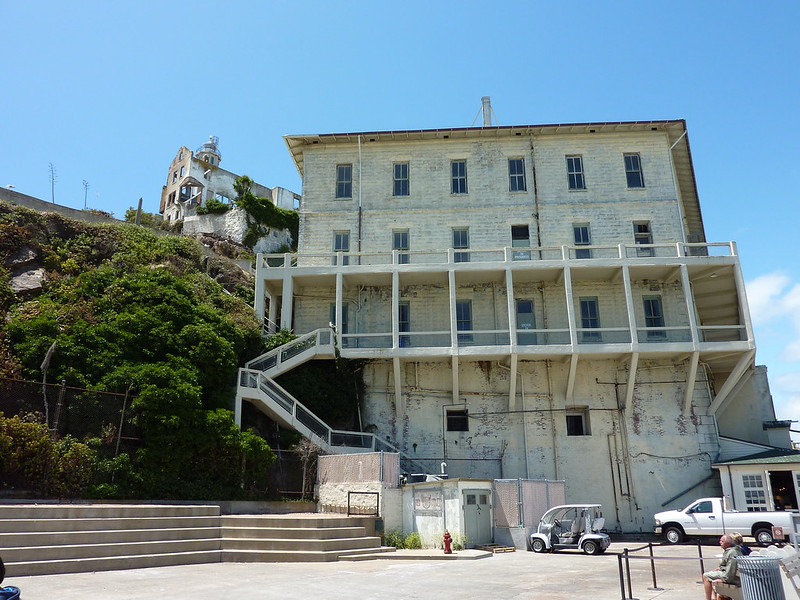
Credit: Gary Bembridge / CC BY 2.0
Building 64 is the first notable building you’ll see after getting off the ferry and setting foot on Alcatraz. One of the oldest structures on the island, the building has lived through the many versions of Alcatraz — from fortress to military prison and federal prison to national park. The original bombproof structure on the ground floor housed cannons and soldiers when Alcatraz was fortified to protect the San Francisco Bay.
The structure still features large square windows meant to be cannon ports. Barracks were built in the 1860s on top of the fortified structure when the island became a military prison to house the guards. In 1905, the open barracks were enclosed and divided into apartments, creating a three-story apartment building that would house correctional officers and their family members.
Today, the bookstore, theater and an exhibit space occupy the bottom part of the building.
4. Sally Port and Guardhouse
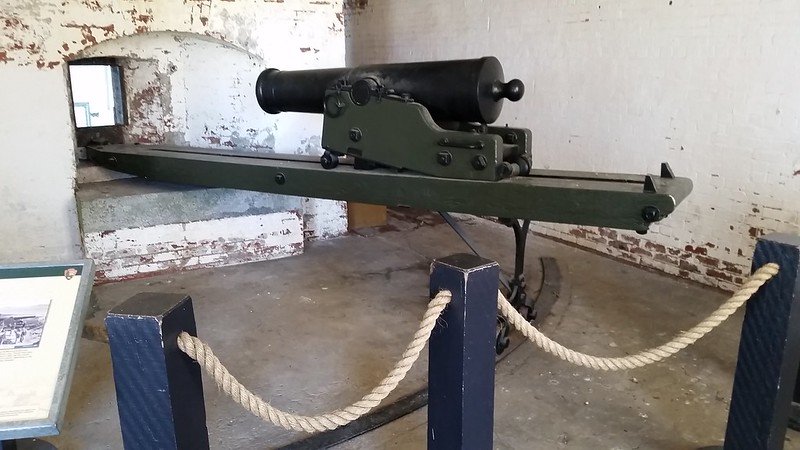
Credit: Cifraser1 / CC BY 2.0
Go past Building 64, and you’ll walk through what used to be the Sally Port and Guardhouse complex. Built in 1857, this is one of the oldest structures on the island.
It was meant to defend the fort atop the hill with a moat, gun ports, and artillery. But this defensive equipment was never used. The Guardhouse later served as a prison for Army soldiers accused of various crimes. Other military prisoners were also held there until officials expanded prison facilities at the island’s summit. The Guardhouse structure was also used as a library, theater, chapel, and schoolhouse.
5. Officer’s Club
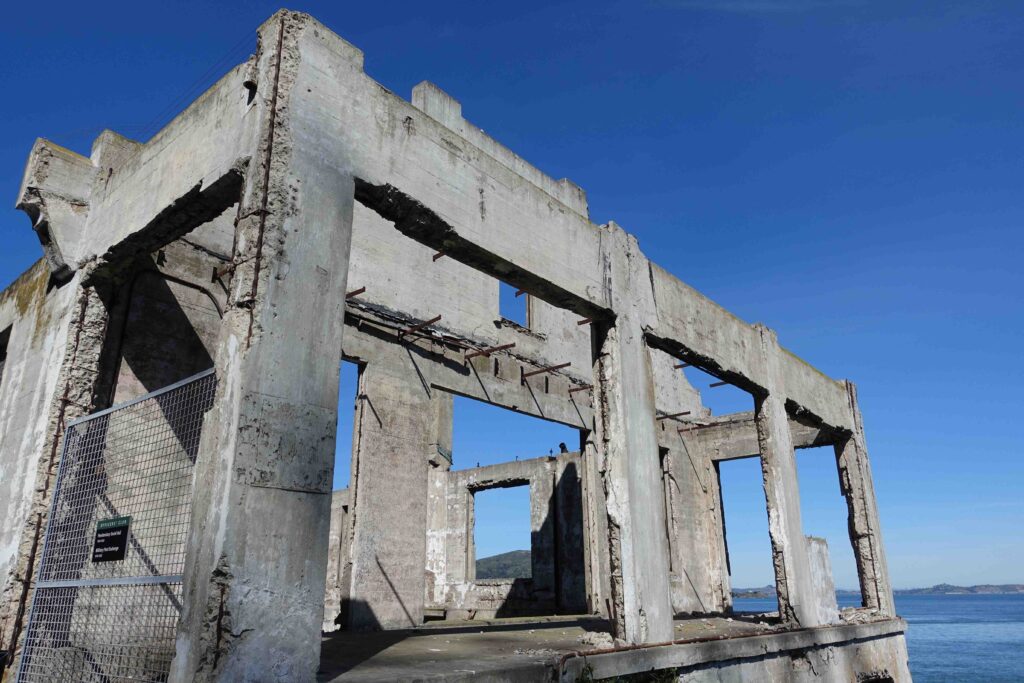
One of the picturesque ruins you’ll find on Alcatraz is the Officer’s Club or Social Hall.
In the early 1900s, when Alcatraz was a military prison, the building was used as a post exchange, which included a general store, cafeteria, barbershop, and post office.
When the military transferred the island to the Department of Justice, the building became known as the “Social Hall” or recreation center. It was the social center for staff and their family living on the island and served as a venue for events, meetings, celebrations, and holiday parties.
Activities inside the building, including pool tables and bowling alley lanes, made it a favorite hangout spot for teens. For safety reasons, the Social Hall only opened at night — when prisoners were locked in their cells and accounted for.
Why is it in ruins now? During the Native American occupation in 1970, the building caught fire, leaving only a burned-out shell.
6. Warden’s House
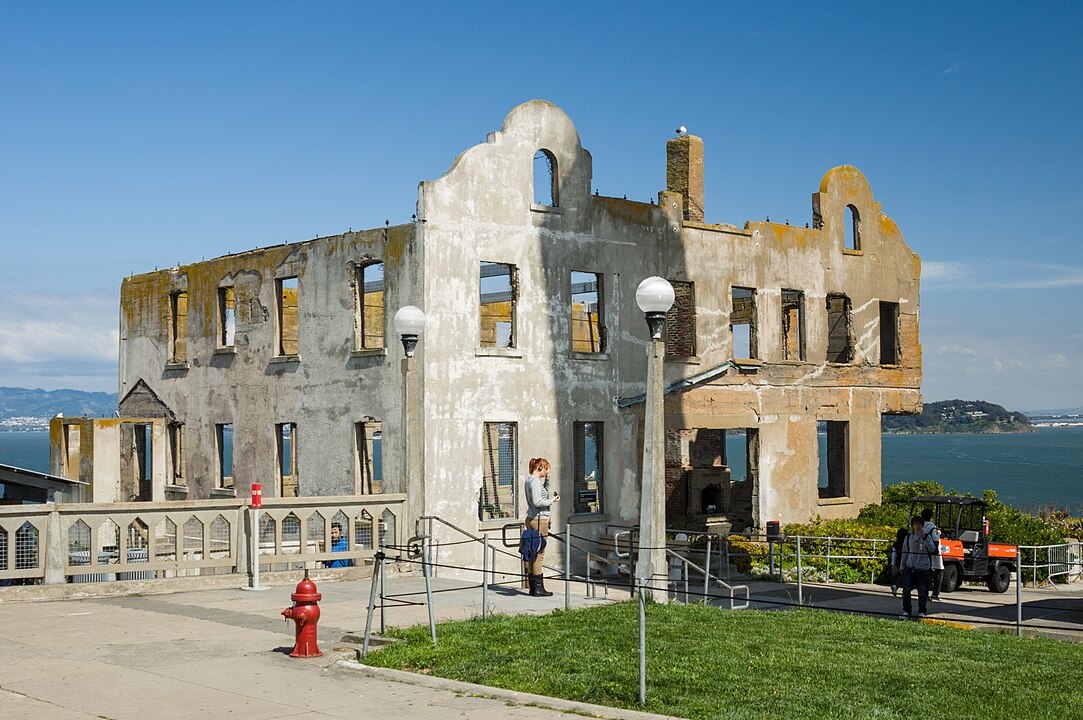
Credit: Adam Kliczek / CC-BY-SA-3.0
Built in the 1920s, the Warden’s House is a massive structure right next to the infamous cellhouse. It’s not so much a house but a mansion.
Official National Park Service information says the building featured three floors and 15 rooms, but other sources have stated that the building once had as many as 17 rooms.
This former home of the commandant of the military prison, which boasts a phenomenal view of the San Francisco skyline, later housed four wardens who oversaw the federal prison. The house burned during the Native American occupation between 1969 and 1971, and park officials have had to do extensive work to preserve what’s left of the historic structure. If you’re visiting during spring, you can enjoy beautiful blooms in the gardens next to the Warden’s House.
7. Model Industries Building and New Industries Building
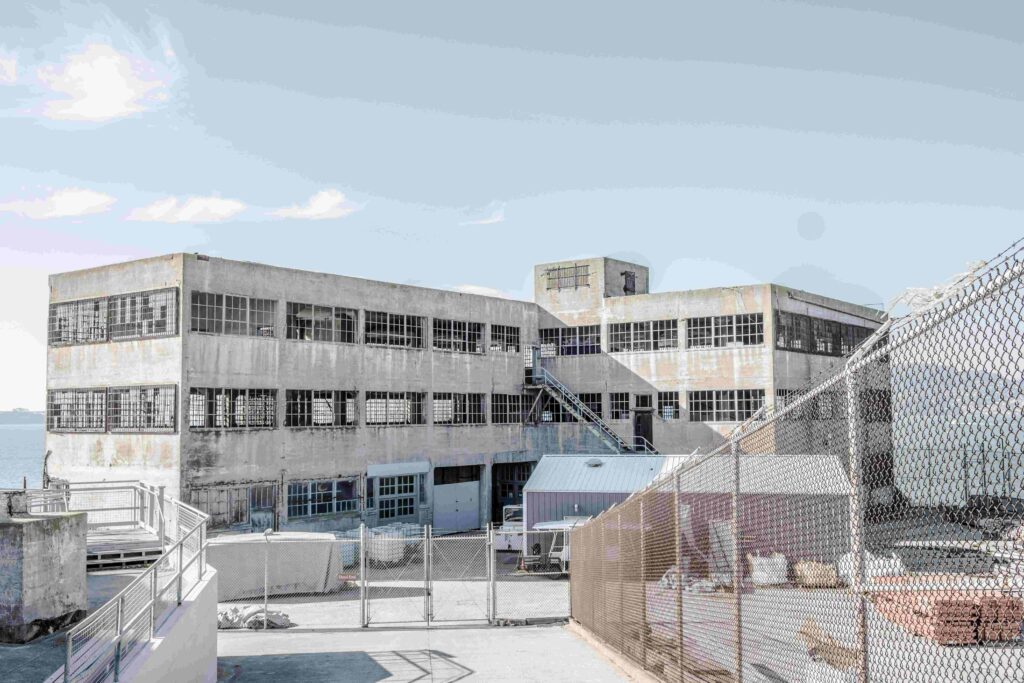
Both of these buildings were used for prison retraining and development. The Model Industries Building was built first in 1921. The three-story building at the edge of the island’s cliff featured a blacksmith shop, plumber’s shop, band practice room, a vocational school, and more for the military prisoners. It was also used as a laundry for military personnel stationed across the Bay.
When the Bureau of Prisons took over, officials were unhappy with the building’s layout and lack of security. So they built the New Industries Building in 1939 and moved the laundry operations there.
Incarcerated men on Alcatraz worked inside the New Industries Building, manufacturing mats from old rubber tires, crafting furniture, and producing brushes, clothing, and gloves. During World War II, the men made cargo nets for the U.S. Navy and repaired steel flotation buoys for anti-submarine nets in the Bay.
The New Industries Building is used as an exhibit space today and is open for a few hours a day (check the dock schedule once you land) for more information.
8. Powerplant and Quartermaster Warehouse
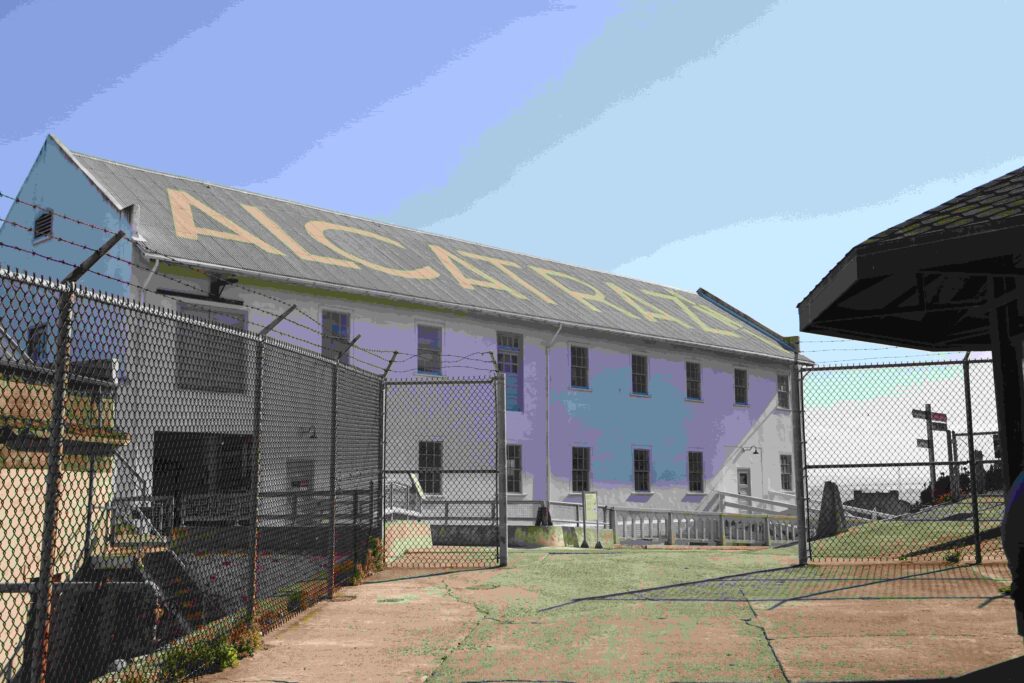
These two buildings were essential to the function of Alcatraz as a military prison and federal penitentiary. Because of this, prisoners were mainly kept out of this area — unlike other facilities, where prisoners were often working.
- The Power Plant, built in 1912, provided electricity and kept water pumps running throughout the island’s facilities.
- The Quartermaster Warehouse, built in 1921, featured the office of the Post Quartermaster, the person responsible for the island’s maintenance and supplies.
The four-level warehouse also served as storage and, during the military prison years, was the location of the commissary. When Alcatraz became a federal prison, the warehouse maintained many of the same functions (minus the commissary) and became an office, storage and workshop space (for equipment repairs).
You’ll notice “ALCATRAZ” painted on the roof with an arrow pointing north. This was a helpful point of reference for aviators back in the day as they navigated the bay area.
The building is the site of graffiti and paintings from the American Indian Movement occupation from 1969 to 1971. When the warehouse underwent renovations and restoration in 2016-2017, the workers went to great lengths to preserve the paintings. These buildings are not open to the public, but park officials encourage visitors to look at the exterior walls and the paintings.
Fun fact: The side of the building facing the water is also an area where protected birds nest.
9. Water tower
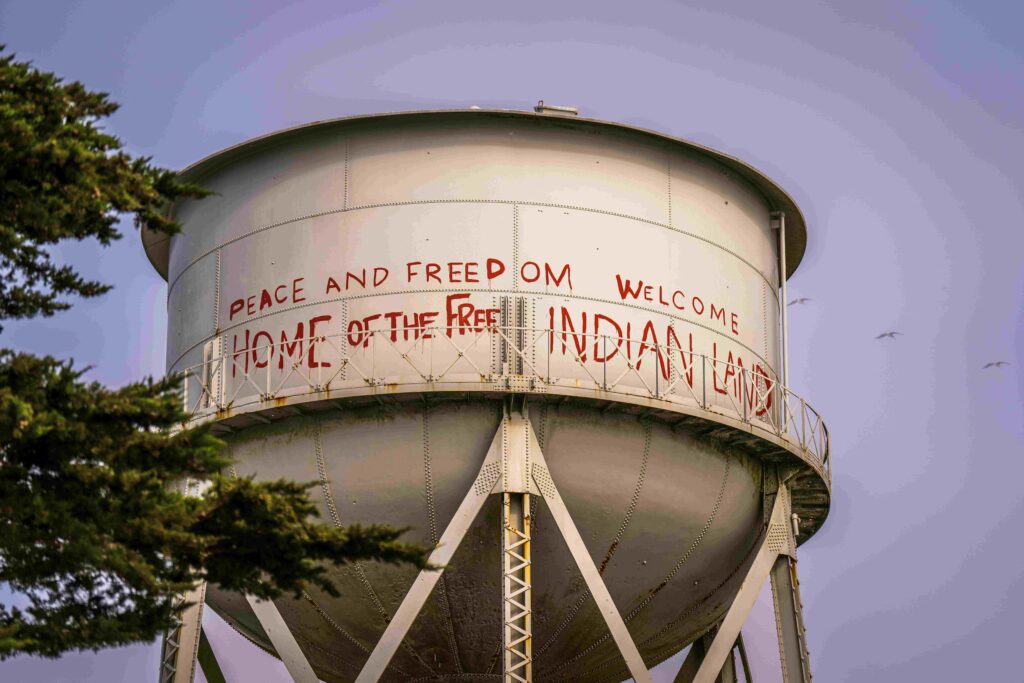
One of the tallest structures on the island, the water tower is one of the more noticeable features when you’re riding to the island from the ferry. Built in 1940, the tower stored the island’s only water source, used for the prisoners’ drinking water and laundry operations and as water reserves in case of fires.
Activists painted political messages on the tower during the Native American occupation of Alcatraz from 1969 through 1971. When the water tower underwent restoration from 2011 to 2012, park officials invited family members of Richard Oakes, a leader and key figure of the occupation, to recreate the writings.
10. Lighthouse
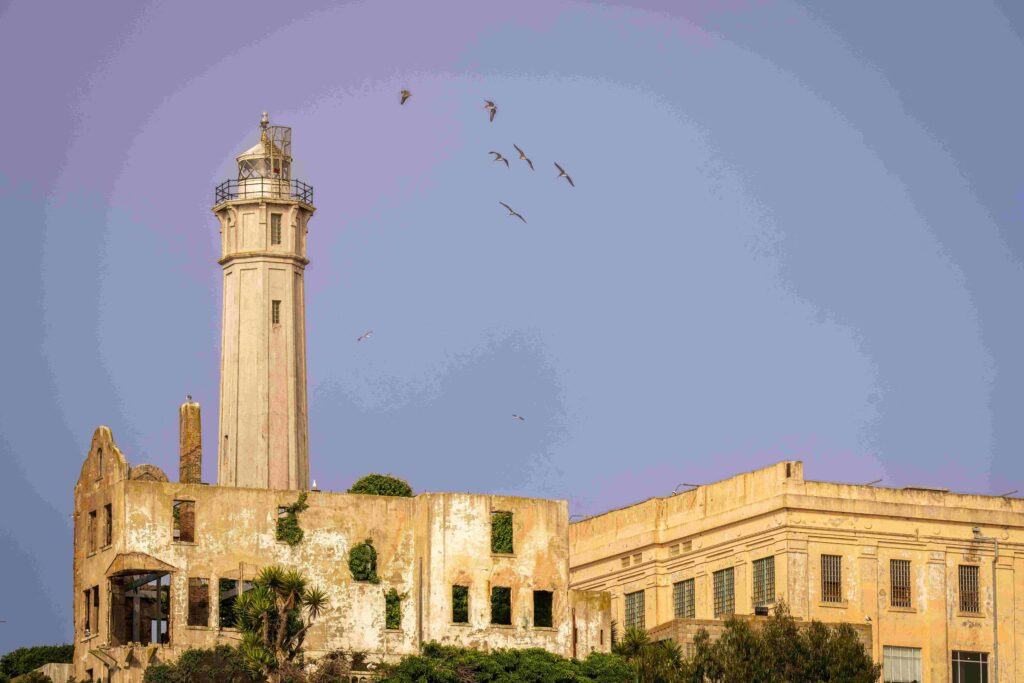
The island’s original lighthouse was built in 1854 as part of the citadel complex on the island’s summit. It was the first lighthouse on the West Coast and helped vessels navigate the bay. After the construction of the cellhouse, a newer, 95-foot-tall lighthouse structure was built in 1909. That newer lighthouse became automated with a modern beacon in 1963, the same year the federal prison closed.
11. Military chapel
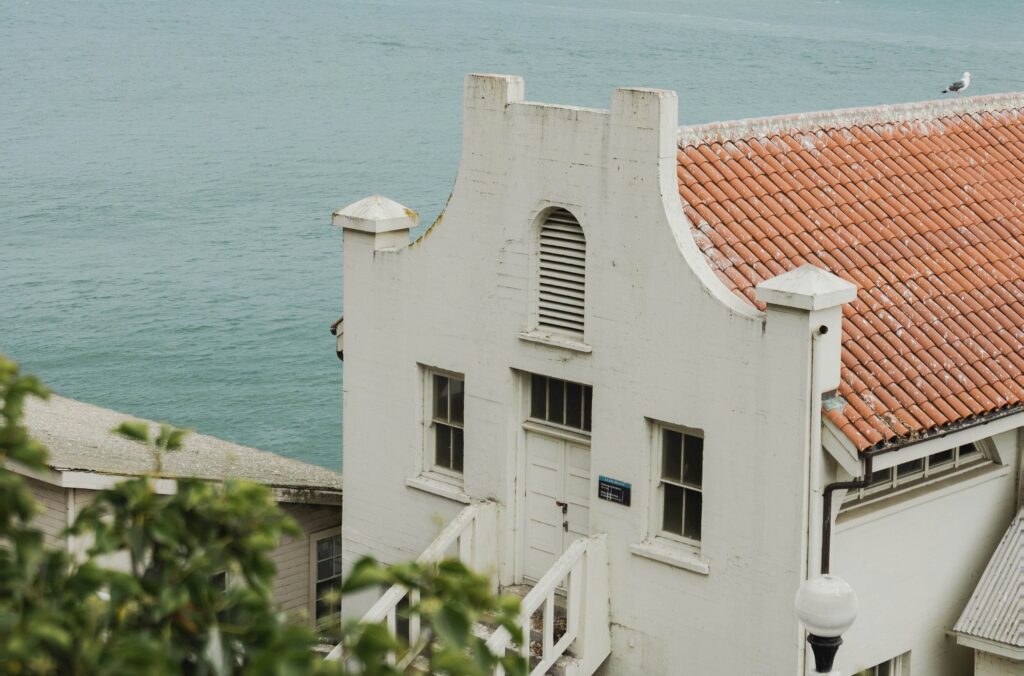
Built in the 1920s, the military chapel was an additional building constructed atop the Guardhouse. You’ll notice its mission-revival architectural style while walking up the road to the cellhouse.
The building served as living quarters for military personnel and their families as well as a school and chapel. When Alcatraz became a federal prison, the whole building became living quarters for prison staff, especially those who were unmarried and didn’t have families. It eventually became known as the “Bachelor’s Quarters” for this very reason.
Explore Alcatraz
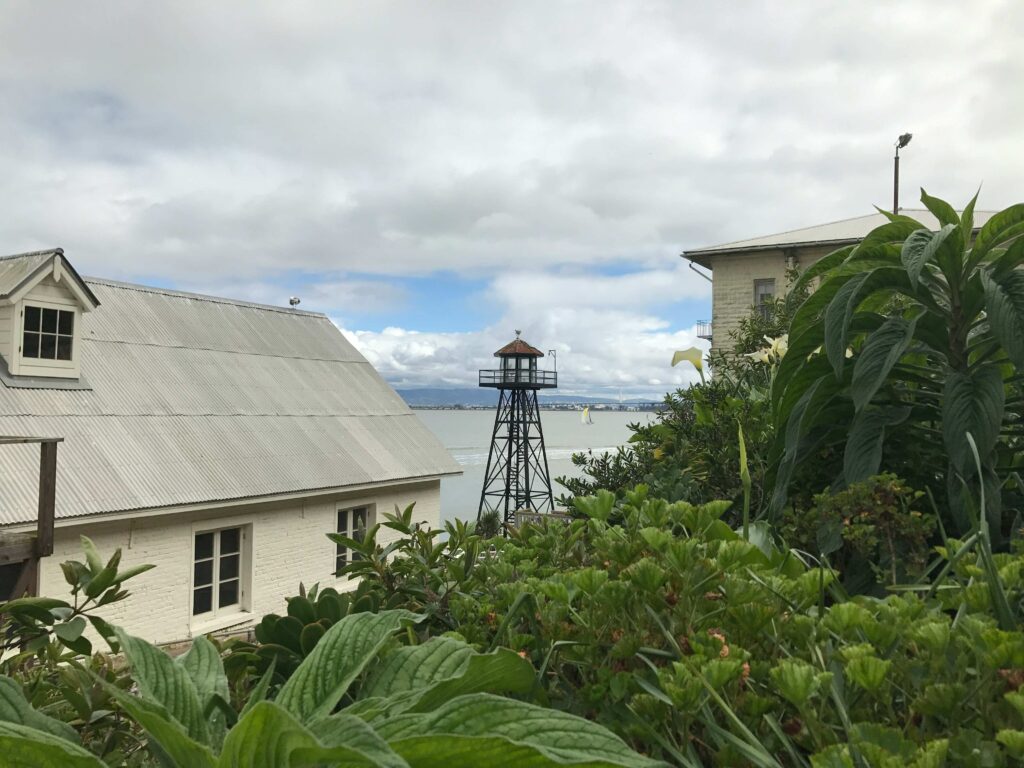
There’s so much more to explore on Alcatraz, from the gardens to the birds to the buildings to the exhibits. The only way to experience it for yourself is to take a tour!
Join any of our guided tours and you’ll get to take a cruise at the end to this historic and fascinating island. We can’t wait to show you the best of the San Francisco Bay!
When people think of Alcatraz, the first thing that generally pops into their minds are criminals and concrete — not natural beauty and wildlife. They’re much more likely to have heard of the notorious “Birdman of Alcatraz” than the scores of birds that live there today.
But local birders and wildlife enthusiasts from around the world know that the island is an incomparable haven for our feathered friends. It’s the place to go in San Francisco if you’re interested in birdwatching, whether you’re a novice birder or have dozens of expeditions under your belt.
In this guide, I’ll share how to explore Alcatraz to maximize your birdwatching fun, including what parts of the island to visit and when to go.
Why Alcatraz is great for birding
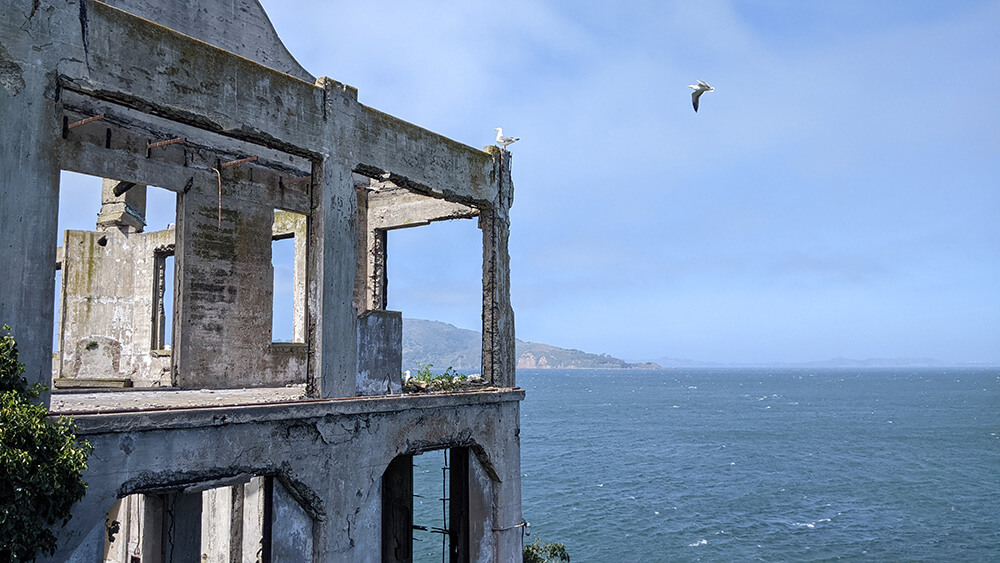
The Rock is famous for the harsh, rugged landscape that made it the perfect place to put one of the most draconian prisons ever built in the history of the United States.
But its isolation, coupled with the relative closeness to the mainland that made the prison particularly agonizing for prisoners and staff who lived there, is part of what makes it so perfect for birds.
They don’t have to travel far to forage for food for themselves or their young. At the same time, there are no mammalian predators there, and humans are only allowed in specific parts of the island at specific times, so it’s a very safe place for even the smallest songbirds, such as warblers and song sparrows.
On the island, you can see so many different kinds of birds. Here are just a handful:
- cormorants
- sparrows
- herons
- egrets
- gulls
- pigeons
- falcons
- ravens
When I went to Alcatraz for the first time, my daughter, who was 7 years old at the time, ended up feeling a little overwhelmed inside the penitentiary from all of the crowds and the sounds reverberating off of the concrete walls. We stepped outside to get some fresh air and found there was much more to Alcatraz than we had first realized as bird after bird grabbed our attention.
Both of us being nature lovers, we ended up spending more time outside wandering the grounds and exploring the tide pools than indoors at the main attraction. We left wanting to know more about the beautiful creatures that make the island their home today, so we made a plan to return soon — this time, with binoculars.
After a little research, I realized that Alcatraz is a world-famous hotspot not only for travel influencers and history fans, but also for birders. There are birds there that you won’t see anywhere else in California, and many of the seabirds that live there normally only make their homes on offshore rocks, meaning they’re generally out of reach for most nature lovers, unless you happen to have a boat.
Taking a trip to Alcatraz to explore the wildlife means you’ll be able to see the nesting, mating, and family behaviors of thousands of birds who make The Rock their home, no personal yacht required.
It’s also a gorgeous place to spend the day if you enjoy nature in general and want the opportunity to explore a unique ecosystem that’s off the beaten path.
Either way, you can find lots to see and do on The Rock that is surrounded by sea and salt, rather than prison walls.
The bird history of Alcatraz
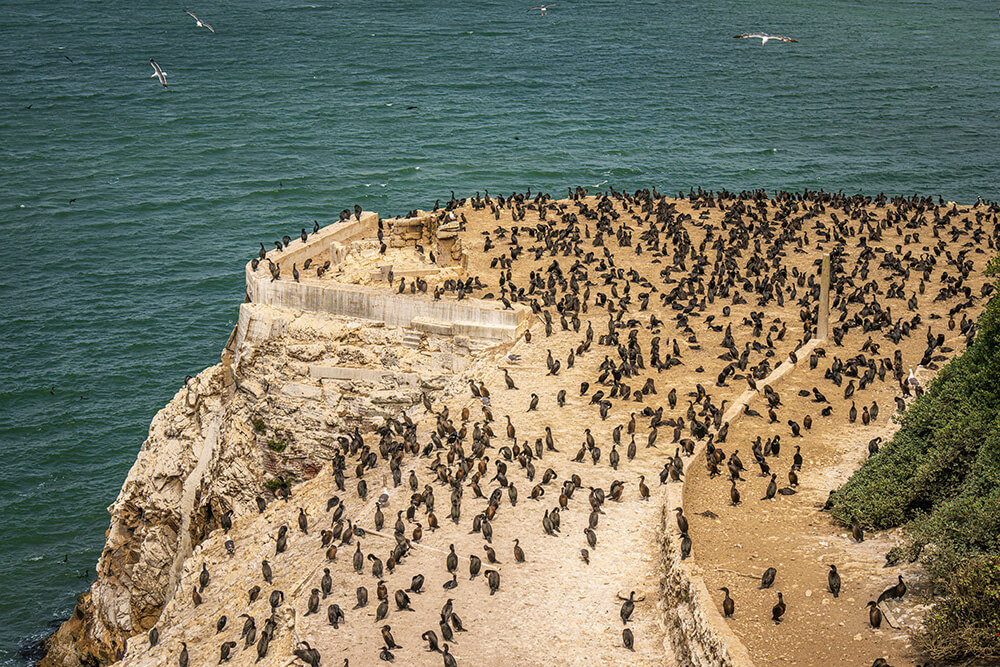
The name “Alcatraz” actually comes from the island’s deep history as a safe haven for birds. When the Spanish explorer Juan Manuel de Ayala first visited the island in 1770, he dubbed it “Isle de los Alcatraces,” or “Islands of the Seabirds,” inspired by the abundant avian life he found there.
Over the next several decades, it continued to be called “Island of the Birds” or “White Island,” referring to the plumage of pelicans and western gulls that were so abundant there. Eventually, the island became known as Alcatraz.
While Alcatraz was being used as a military base and prison, birds were rarely seen and tended not to nest or migrate there. After the prison closed, however, the island sat quiet and mostly untouched for nearly a full decade. During that time, birds that had not been seen for over a century began flocking back to its rocky shores.
When go birding on Alcatraz
The National Park Service recommends visiting Alcatraz sometime between the end of winter to the beginning of summer to glimpse the best of the birdlife, so you can’t go wrong with a spring trip to the island.
However, there are different species of birds that come and go during all times of the year, so no matter when your trip is planned, be sure to bring a pair of binoculars and a pair of sturdy hiking shoes. Even if you’re mostly planning on spending time indoors at the prison, just a few minutes of walking to explore the natural beauty of the island can really pay off.
Where to spot birds on Alcatraz
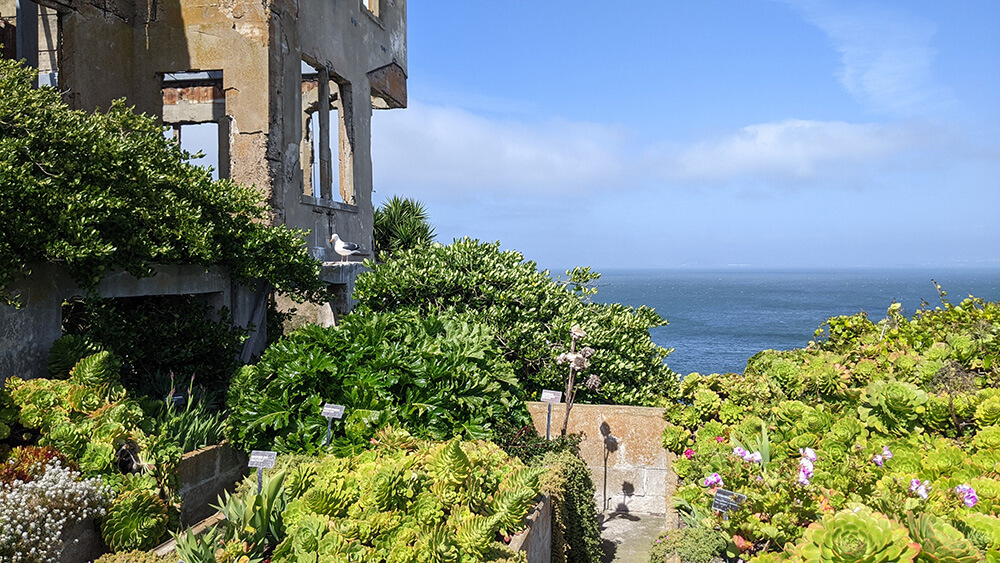
Even before you get off the ferry, you’ll begin to get hints of what awaits you, as large numbers of gulls and cormorants tend to be active in the sea surrounding the island.
The gulls will continue to be your companions almost everywhere on Alcatraz, adding to the eerie atmosphere of the notorious prison as they perch on just about every structure. Their favorite place tends to be the lighthouse, though, or just beneath it, which is where they nest.
Near the dock, you might get a glimpse of great blue herons nesting in Alcatraz’s biggest eucalyptus tree, which sits above the Alcatraz Rose Garden. The great blue herons are one of The Rock’s many avian success stories, growing from only a handful of active nests before 2016 to over a dozen today.
Nearby, you may be able to spot a black-crowned night-heron (which, if you haven’t seen one, is just as spooky looking as it sounds) on the heavily overgrown wall above the amphitheater. These birds, as well as their close cousin the snowy egret, were hunted almost to extinction in the early 1900s.
Both have found sanctuary here on Alcatraz for the past several decades, helping to bolster their numbers throughout the Bay Area. They build their nests in the shrubs, trees, and bushes throughout the island, but you’re most likely to see them near the amphitheater, or along the island’s west road (when it’s open — more on that in just a moment).
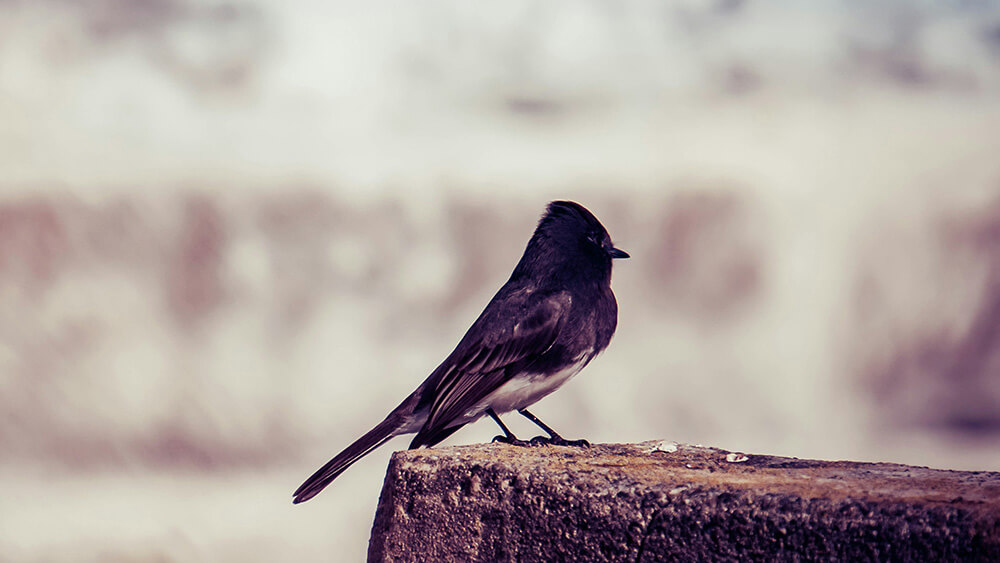
Heading up the road towards the cell house is where you’ll find many of the smallest and cutest feathered friends on the island, including the white-crowned sparrow, song sparrow, black phoebe, Anna’s hummingbirds, yellow-rumped warblers, and Townsend’s warblers. Many of these smaller birds tend to be more common in fall and winter.
You will also probably see ravens roosting about and peering down their long beaks at you, fitting the general theme of the island.
Unique bird species on Alcatraz
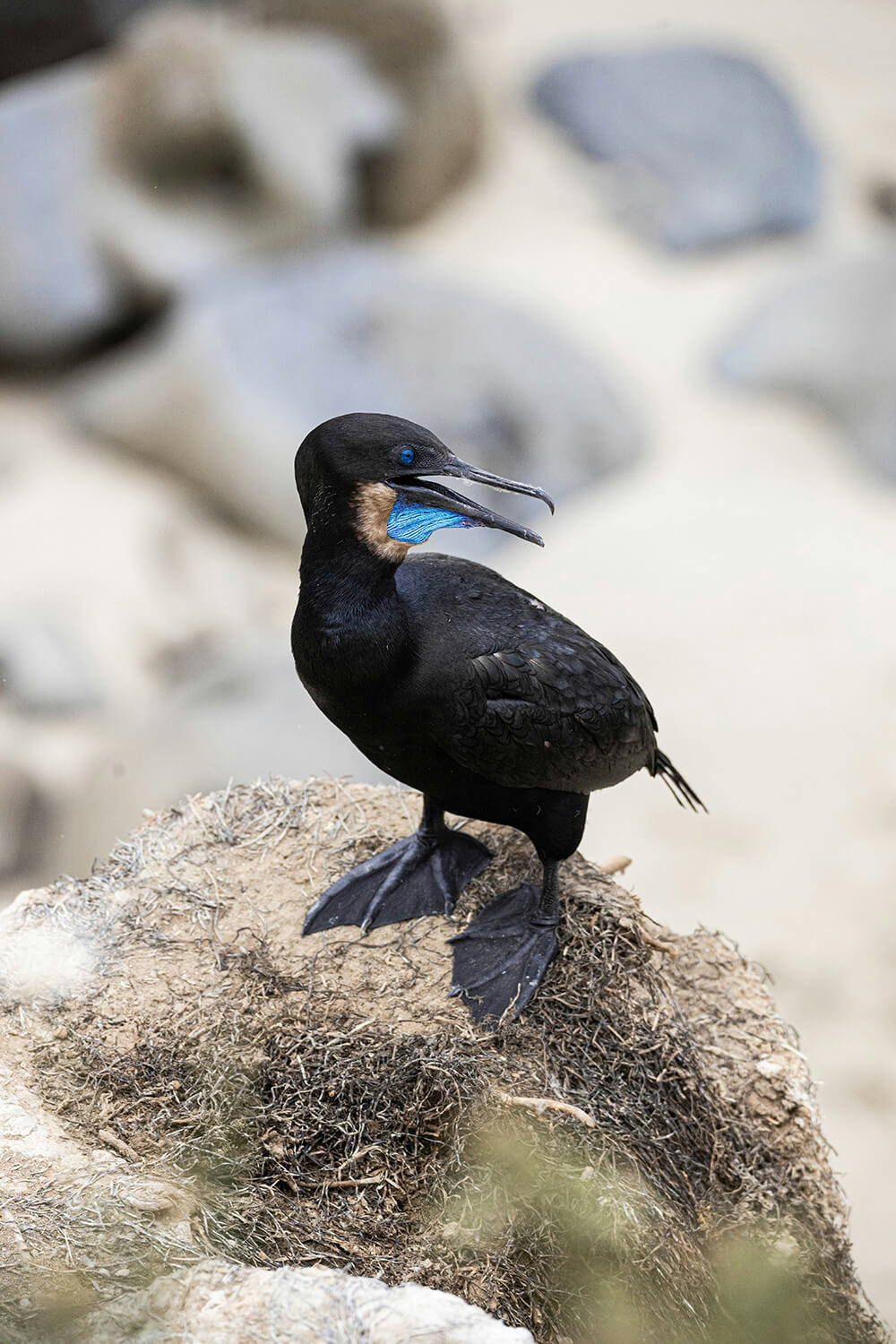
Alcatraz is the only breeding colony site in the San Francisco Bay for several types of cormorant, including the Brandt’s cormorant, which is an iridescent black bird with a bright blue throat patch that they like to show off by pointing their beaks up to the sky (it’s a courtship thing).
These birds make their home on the rocky western shore of the island, where you’ll also have a chance to see black oystercatchers, egrets, and herons — and to snap shots of the gorgeous view of Baker Beach across the water.
The past several years have given visitors to Alcatraz the epic experience of seeing as many as 3,300 breeding pairs of these elusive birds, who spend most of their lives far out at sea, diving deep into the ocean to hunt and eat. They head to the island in early February, which is when the National Park Service closes down this part of the island, giving them the best opportunity to hatch and raise their young as possible before migrating later in the summer.
Local tip: If you happen to be on Alcatraz during the Brandt’s cormorant breeding season from February to June, don’t despair. Even when the west part of the island is closed, you’ll likely be able to get a glimpse of these birds from the overlook above the parade grounds.

The west side of the island is also where you’re most likely to see the two birds of prey who make their home on The Rock: the tiny burrowing owl and the majestic peregrine falcon.
This part of the island is best accessed by the Agave Trail, which starts just south of the ferry dock and goes along the base of a steep hillside that features four different agave species. The trail is only open between late September and early February, which is exactly when you want to go, both to take advantage of the most fog-free weather of the year in the Bay and because it’s when you’re most likely to see teeny burrowing owls bobbing up and down from within the rubble scattered across the parade grounds. These small survivors, designated as a “species of special concern” in California, have been pushed out of much of their original habitat across the state, so finding solace on Alcatraz has been particularly important.
The sanctuary of the island has also been particularly important for peregrine falcons, who were nearly driven to extinction in the 1970s because of the impact that the pesticide DDT had on them (this is actually what led to the banning of DDT nationwide).
They rebounded slowly, coming off the endangered species list in the 1990s, and today make their homes across California and the rest of the country in rocky outcroppings, usually far away from humans and often at very high elevations.
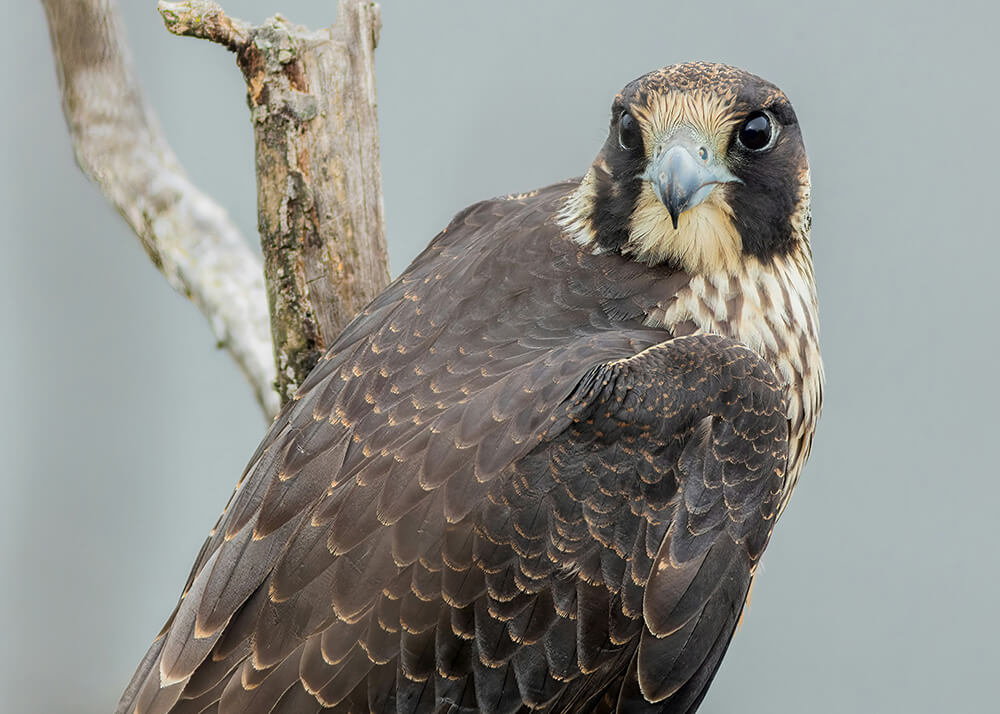
Over the past several years, however, Alcatraz has been home to a special peregrine falcon named Larry — short for Lawrencium — who hatched in the UC Berkeley bell tower, just across the Bay. Larry eventually found a mate, and began breeding on Alcatraz in 2020. She has had at least three clutches of baby falcons in that time, with the newest batch, born in April 2024, going on to become mini-influencers, starring in their own livestream on the National Park Services website so that you see them up-close any hour of the day.
But for an even more personal experience, try spotting Larry in her own neighborhood. Just don’t blink — like all peregrine falcons, she and her mate can fly over 200 miles per hour.
Tour Alcatraz Island and more
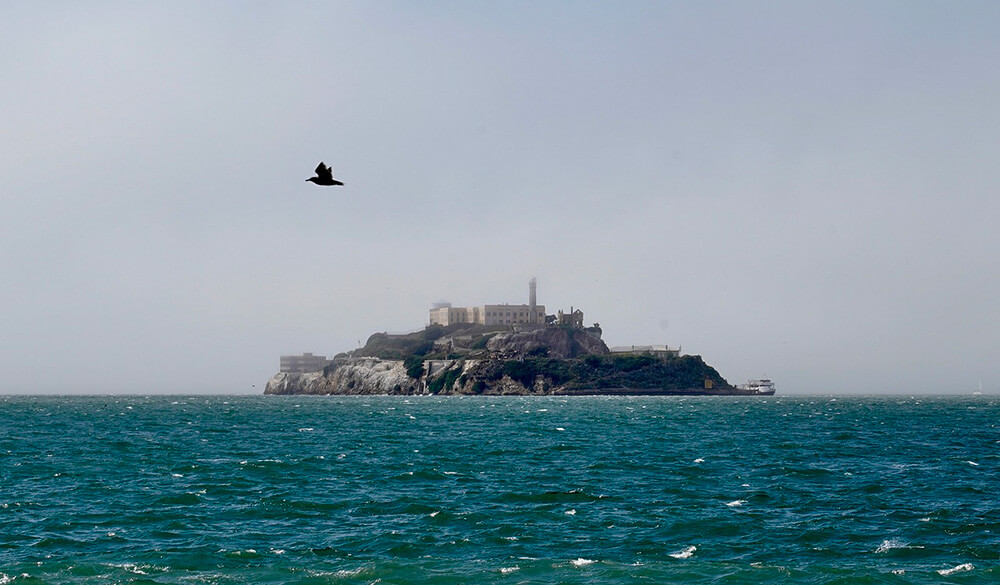
There are many reasons that Alcatraz Island makes it on every “top things to do in San Francisco” list. In fact, it’s regularly rated by Tripadvisor travelers as one of the top landmarks in the country. (It’s been No. 1 multiple times and came in fifth in 2023.)
The natural beauty you’ll experience here is just one aspect of this not-to-be-missed northern part of the city, which also includes Ghirardelli Square and Fisherman’s Wharf. There’s no better way to experience it all than with the guidance of a local, which you can do — including taking the ferry to Alcatraz — as part of our walking tour.
Your local tour guide is a great resource for learning more about SF, and your tour ticket includes a cruise to the island with an audio guide from the National Park Service telling all about the island’s fascinating history.
And remember, whenever you choose to visit, be sure to save time to hike around and explore the wildlife that shelters on the island — there’s really no other place like it.
Alcatraz Island is famous for the harsh, rugged landscape that inspired the construction of one of the most notorious prisons ever constructed. But less well-known is that even with the incredibly inhospitable terrain, a not-to-be-missed aspect of the Rock are the gorgeous gardens that have been cultivated there for over a hundred years– a fascinating and beautiful remnant from bygone days.
Today, among the thousands of people who come every year to visit this National Historic Landmark, many make it a special point to see the gardens, which were recently restored after 40 years of neglect in 2003, and have their own story to tell about the resilience and ingenuity of both nature and the human spirit.
Want to see the Alcatraz gardens? Curious when is the best season to visit, what wildlife you might be able to spot, or how to plan your visit? Keep reading. I’ll cover all that and more in this post.
Why are there gardens on Alcatraz?
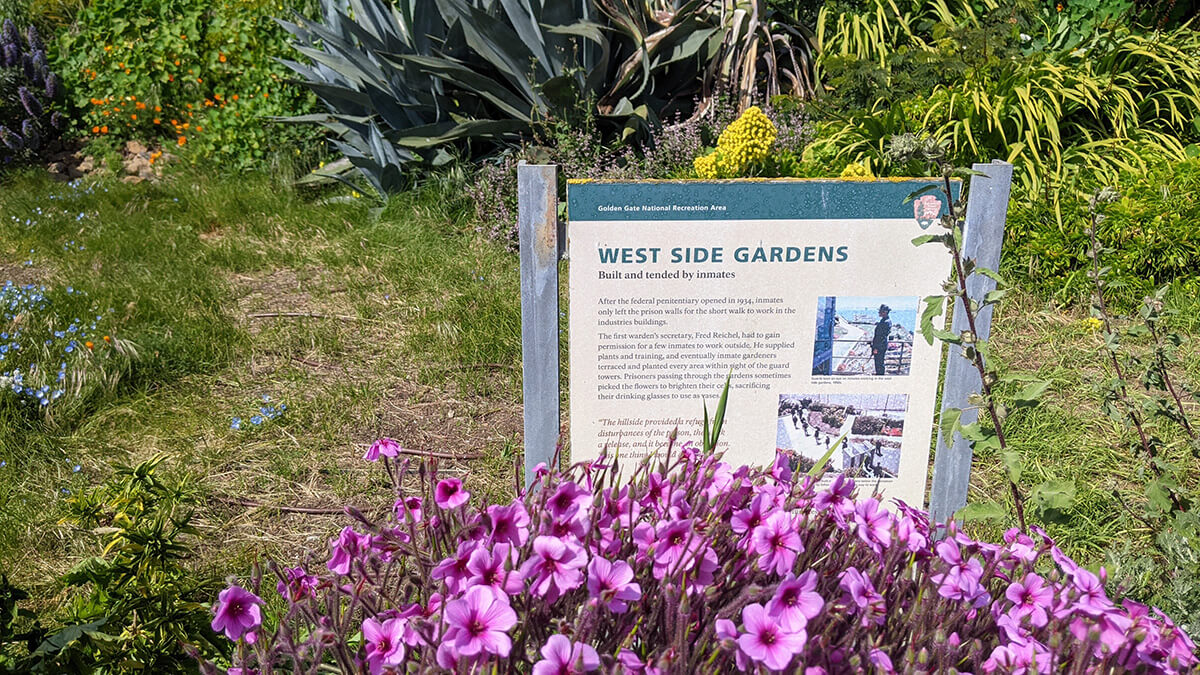
The Alcatraz gardens were tended first by the military wives of the officers stationed there, who were cut off from San Francisco’s bustling gold rush era social scene by the turbulent waters of the Bay. Laer, they were tended by the staff and inmates of the prison. These gardens, filled with roses, herbs, fruit trees and carefree wildflowers, were small but powerful beacons of hope and sunshine in a place well-known for being stark and grim.
The gardens of Alcatraz are made up of seven unique parcels, scattered across the Rock like a patchwork quilt overlaying the concrete and barbed wire remains of the fortress-like penitentiary.
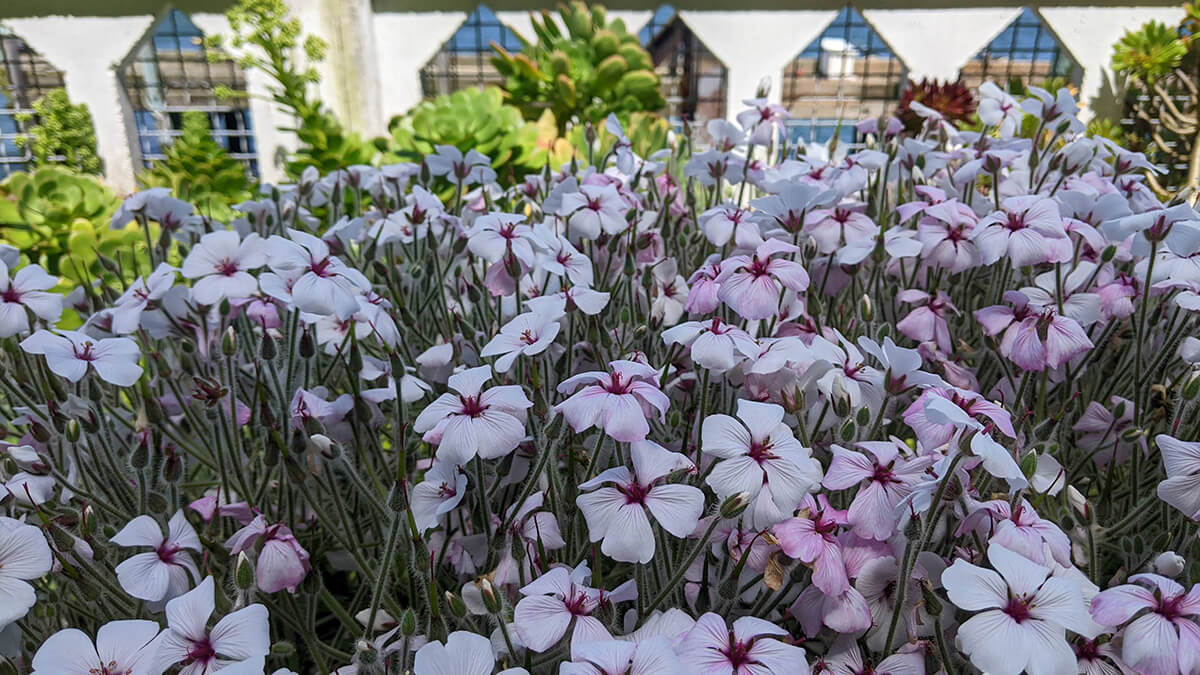
The same conditions that made the prison formidable for the inmates once held there — the steep cliffs, the rocky, uneven terrain, the cold, salty wind, the unyielding fog and mist — make it an unlikely place for most of the plants we think of as “garden plants” to thrive.
And yet, here we are today — with beautiful gardens on Alcatraz.
Through the work of countless hands over many generations, from the convicts of Al Capone’s era to the volunteers who tend the terraced gardens now, this island has become a place of improbable beauty and a safe haven for wildlife.
When to visit Alcatraz Gardens and what to see
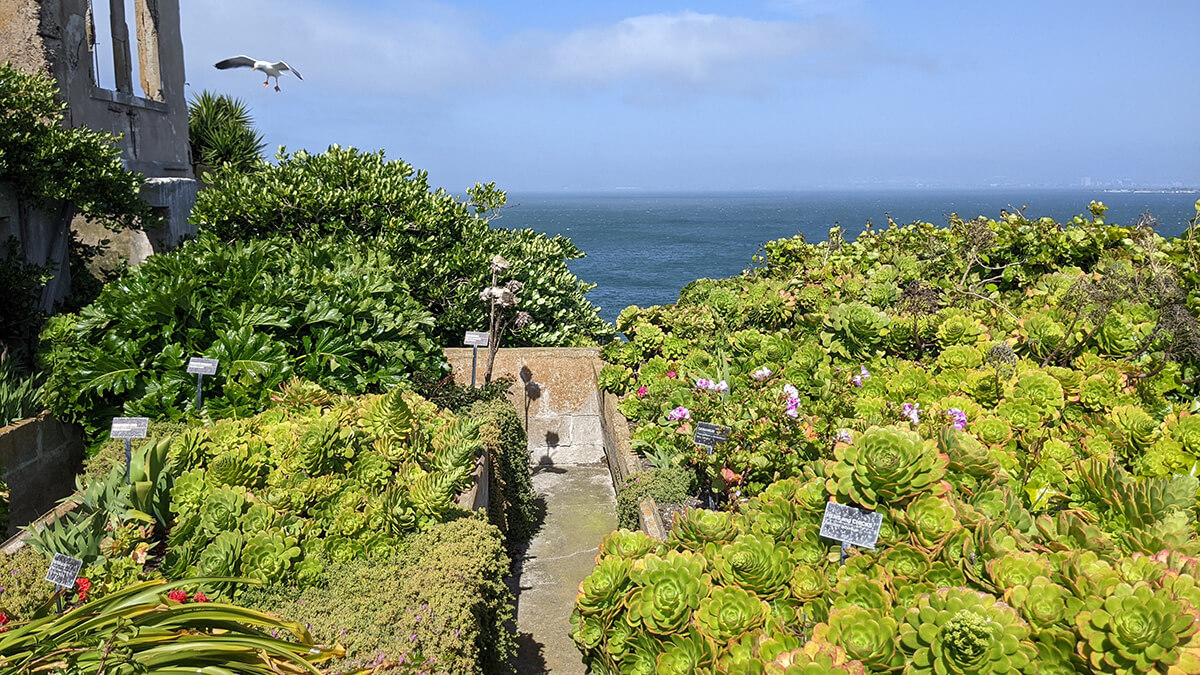
There really isn’t a bad time to visit the Gardens of Alcatraz.
In spring, the Officers’ Row and Warden’s Gardens will enchant you with the scent of pink nicotiana, paperwhites, and plush purple irises. While your friends are posting yet another super-bloom photo surrounded by endless California Poppies, you can one-up them with snaps of terracotta and gold calendulas, spires of foxglove, and sweet peas that feel like they come right out of a fairytale, instead of a prison.
In summer, in addition to the bounty of blooms you’ll see in the Rose Terrace, you’ll find the magenta and pink petals of four different types of fuchsia scattered around the island.
Local tip: Don’t miss the birdbath area in the Prisoner’s Garden, where you may stumble upon a carmine and emerald Anna’s hummingbird, drawn in by the nectar of pineapple sage, frilly geraniums, and vintage ‘Bowles Mauve’ wallflowers.
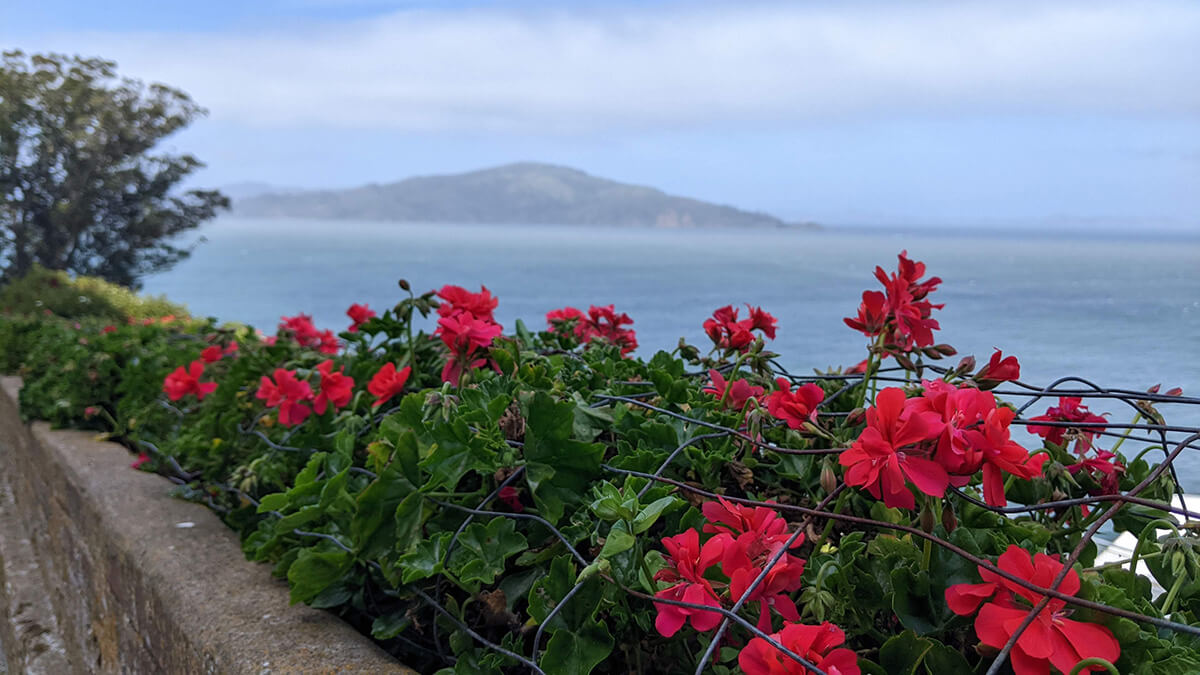
Then in autumn, the summer crowds die down. The temperature cools, and you’ll be able to walk among apple and walnut trees beginning to bear fruit, surrounded by the milk-and-honey tufts of blooming coyote bush and plum-perfect dahlias. Many of these trees are over 100 years old.
You can also take part in the annual Thanksgiving Day events on Alcatraz Island, which have deep roots in the Native American civil rights movement of the 1960s and 1970s.
Winter might not seem like the best time to visit Alcatraz, but if you’re willing to brave the bracing cold winds, you’ll find that this one of the few times of the year that the seemingly-omnipresent San Francisco Bay fog completely disappears, guaranteeing you gorgeous views of both the Golden Gate Bridge and the city skyline from the island.
It’s also the only time of year you can hike the little-known Alcatraz Agave trail, which begins just south of the ferry dock and is only open September through February. The spiky succulents which give this little-known trail its name tower over 40-feet tall, and have an interesting historical element of their own — they were planted in 1930s and ’40s by prison guards and their families both for their stately beauty, and as a way of keeping would-be accomplices of potential escapees from landing boats on the shores of the island.
Tour Alcatraz Island and more
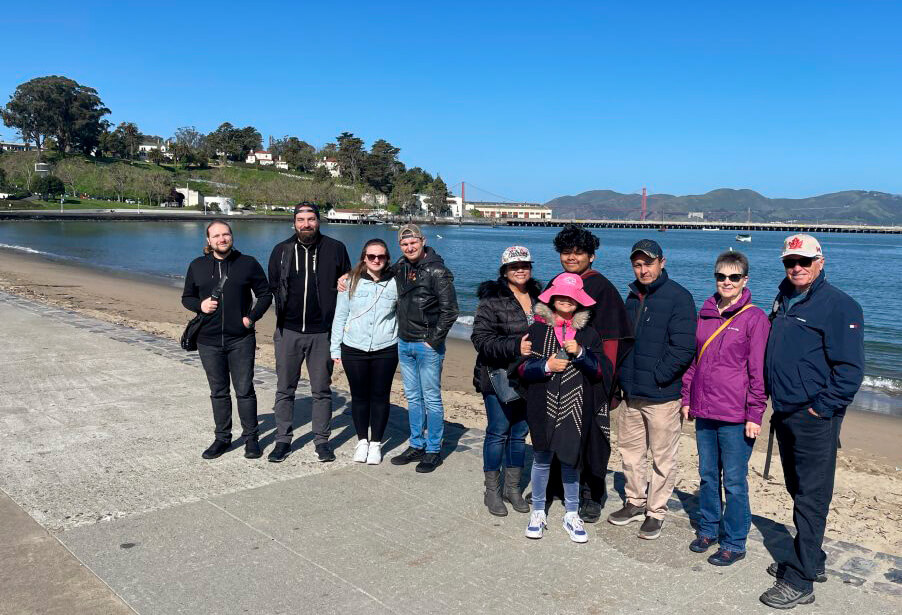
Alcatraz Island is one aspect of the seedy underbelly of San Francisco’s history, which also includes the red-light district known as the Barbary Coast Trail and the wild escapades of the Gold Rush Boom.
The entire waterfront of the city has a rich and colorful history, from the small stalls of seafood that sailors have kept stocked with dungeness crab and salmon for generations to the once tiny chocolaterie that eventually became known as Ghirardelli Square. You can see all of this and take the ferry to Alcatraz as part of our walking tour.
The lost roses of Alcatraz

Credit: Salicyna / CC BY-SA 4.0 DEED
The most beloved of the seven gardens on Alcatraz is probably the Rose Terrace.
Whether you’re a budding rosarian, a history buff, or simply want to take cool photos for your Instagram feed, you’ll want to make it a point to visit in summer. This is when the roses put on their best display and when you can see the rich crimson bloom of ‘Bardou Job’ — a rose thought to be extinct until it was found among the weeds and blackberry brambles on Alcatraz Island.
‘Bardou Job’ is still among the rarest of about 100,000 known rose varieties, but it isn’t the only rare, historic rose on the Rock.
Today over 30 varieties of antique roses are cultivated in the Alcatraz Gardens, from ramblers such as ‘Russeliana,’ first introduced on the island in 1837 and still thriving today, to the sumptuous tea rose the color of a mango lassi, ‘Buff Beauty.’ The seasonal flower show begins in May and continues for months, until mid-autumn or longer, depending on the weather.
Over a dozen of the roses on the Rose Terrace and spread throughout the Alcatraz Gardens are what are known as “survivor plants.” These are plants originally grown by the wives of military officers in the late 1800s or by staff or inmates of the prison before it was closed in 1962. They somehow survived until 2003, when the Garden Conservancy began restoring the gardens.
Enjoy your visit to Alcatraz
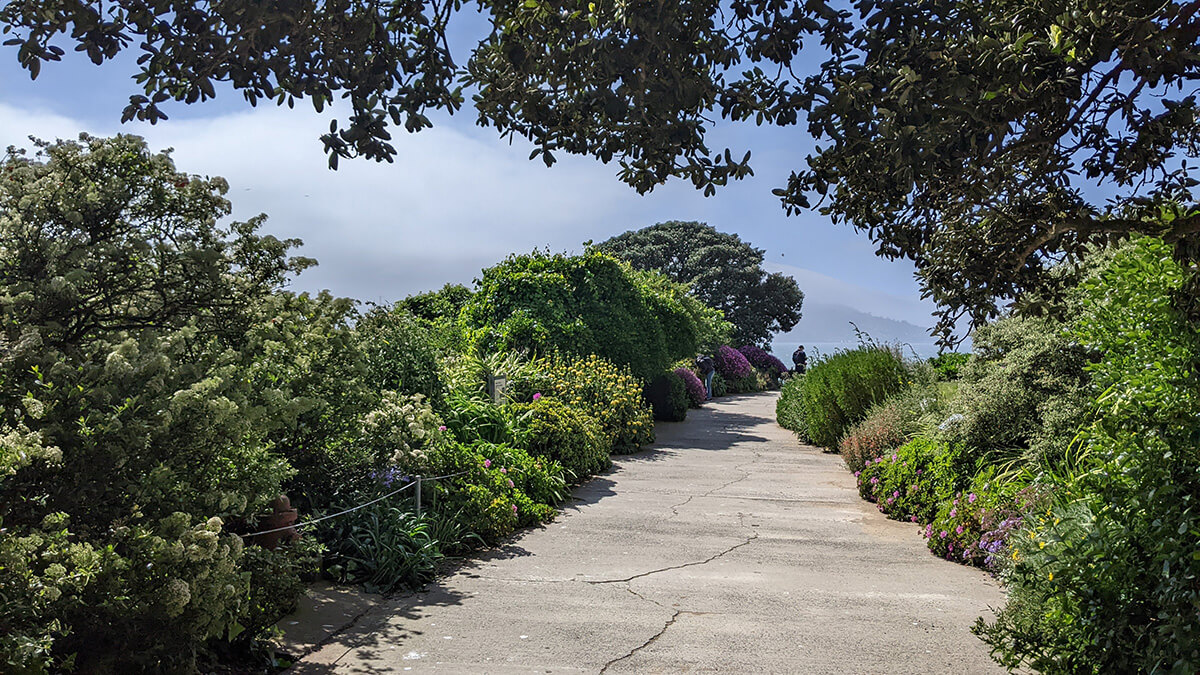
While strolling through the gardens of Alcatraz, it’s tempting to overlook the island’s dark history — the long years of confinement, the ongoing struggle for justice. However, each era of its past is mirrored in the gardens, like the Prisoners’ Garden with fruit and food and the meticulously maintained cutting-flower beds tended by military wives.
Today, Alcatraz is a blend of these varied histories, where remnants from the past converge among the weathered brick ruins and rugged sandstone, lovingly preserved by garden volunteers today.
Curious about the details of getting to Alcatraz and how to get the most out of your visit there? Your SF tour guide is a great resource for learning more about Alcatraz Island and the surrounding area, and your tour ticket includes a cruise to the island with an audio guide from the National Park Service telling all about the island’s fascinating history.
And remember, whenever you choose to visit, be sure to save time to explore the beautiful Alcatraz gardens.
As far as historic federal penitentiaries go, Alcatraz probably tops the list for most infamous — so for many, an Alcatraz Night Tour sounds not only educational but thrilling. What would it be like to tour this island at night? That’s exactly what I’ll share in this guide.
Of course, Alcatraz is famous not only for housing some of the most notorious criminals in American history but also because of its unique location in the middle of San Francisco Bay. On clear and fogless days, visitors can take in sweeping views of the San Francisco skyline, the Bay Bridge and Berkeley Hills to the east, and the famous Golden Gate Bridge.
As many as 1.5 million people visit “The Rock” each year looking to learn not just about the former prison but also the island’s past life as a military fortress, the site of a years-long Native American occupation, and as an ecological preserve for plants, birds, and other wildlife.
So what is the best way to tour Alcatraz Island? There are three options you can choose from: the Day Tour, the Behind the Scenes Tour, and the Night Tour mentioned above. Which one you choose will most likely come down to your budget, how much time you have, and the type of atmosphere you’d like to experience.
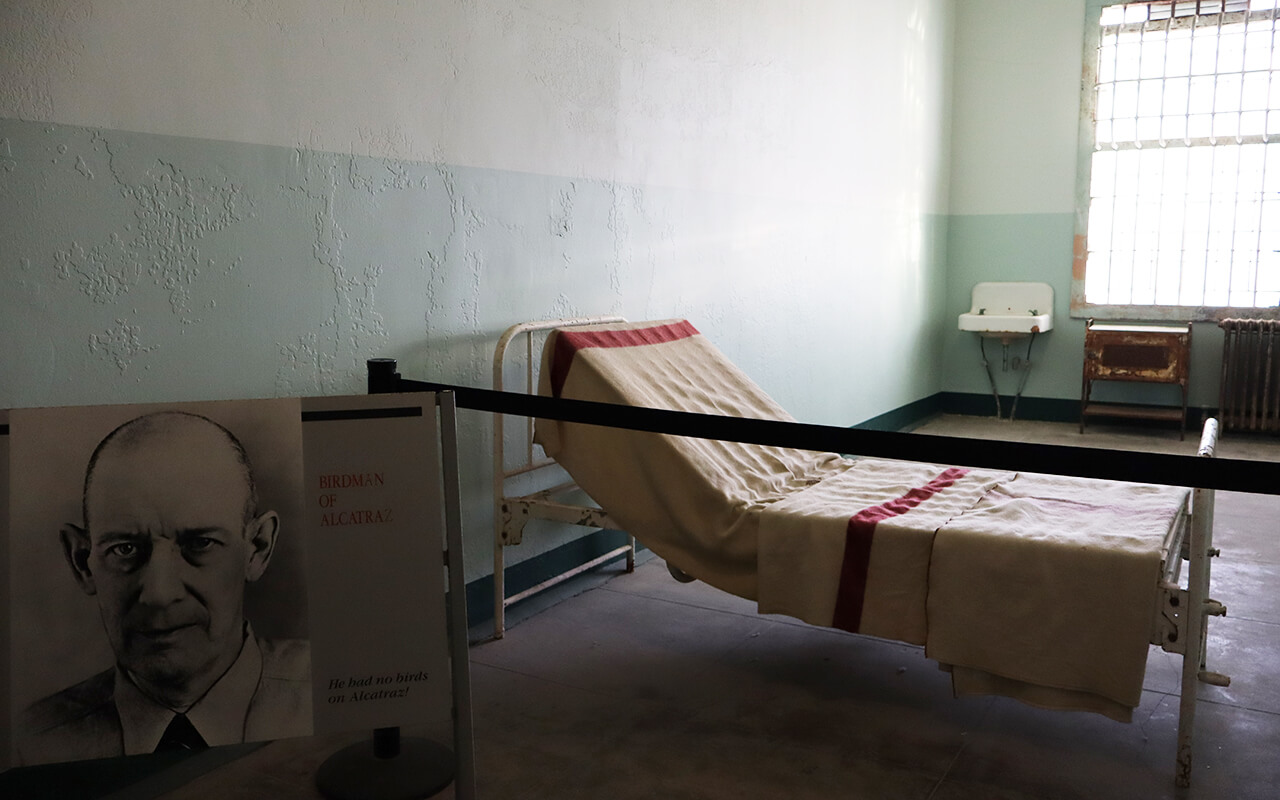
Photos by Marnette Federis
The Alcatraz gardens were tended first by the military wives of the officers stationed there, who were cut off from San Francisco’s bustling gold rush era social scene by the turbulent waters of the Bay. Laer, they were tended by the staff and inmates of the prison. These gardens, filled with roses, herbs, fruit trees and carefree wildflowers, were small but powerful beacons of hope and sunshine in a place well-known for being stark and grim.
The Day Tour provides all of the essentials, and this is what we offer alongside our Fisherman’s Wharf tours — you get a tour with audio guide inside the cellhouse, a ferry ride to the island, and plenty of time to meander through the island’s many gardens and some buildings, some of which are only open during the daytime. The Behind the Scenes Tour, meanwhile, is a more intimate look at areas not usually open to the public but it’s the priciest of all the tours.
The Night Tour, as you might expect, lets you visit the island at night. And walking through a dimly lit, eerie, deserted prison at dusk is a truly unique experience. Curious what this experience is really like? Read ahead to find out.
What is the Alcatraz Night Tour?
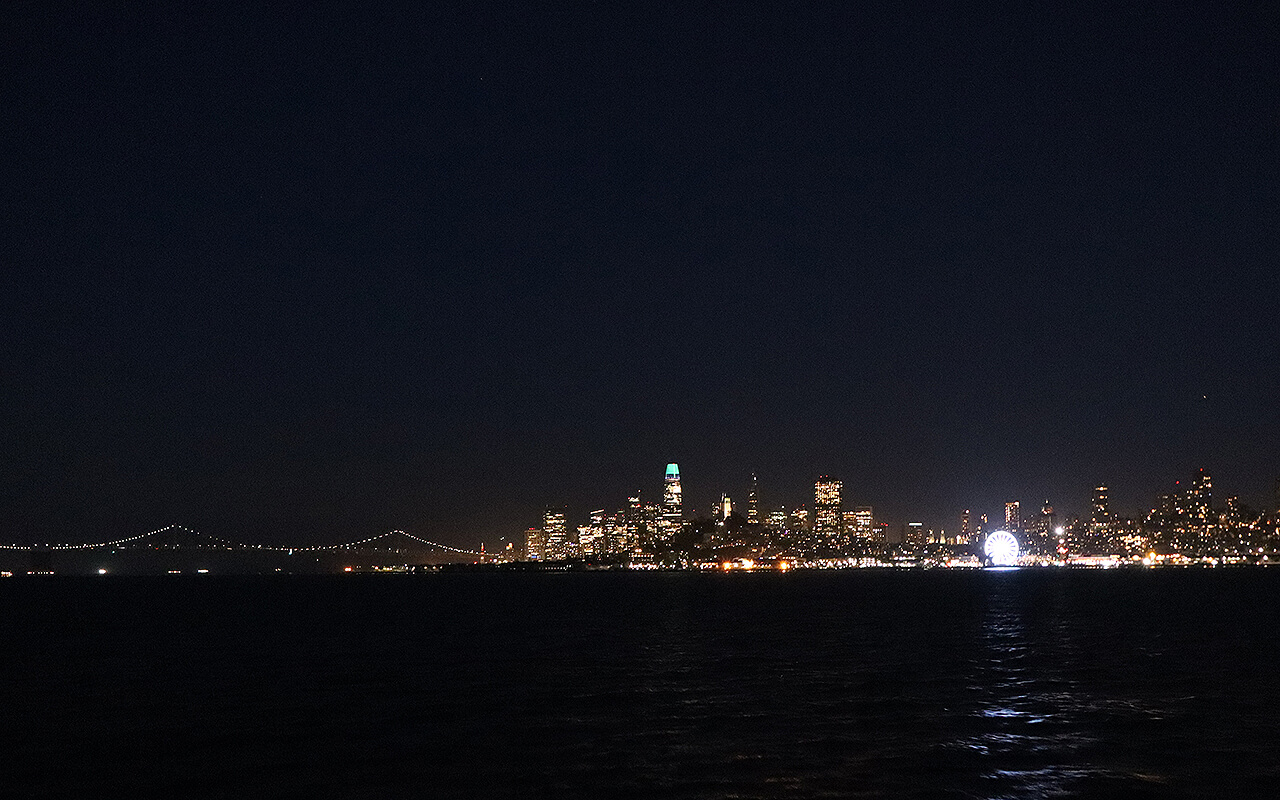
The Alcatraz Night Tour is one of three offered on the island — boats for the night leave Pier 33 in San Francisco in the evening, usually from about 5:30-7 p.m. The limited departure times mean the number of visitors is also restricted, so instead of there being thousands of people on the island, only a few hundred can experience Alcatraz each night.
As you cruise toward the island, you can listen to a narrated tour about the history of Alcatraz as a military fort and its transformation into one of the most notorious prisons in history. The boat also circles the island so you can see areas that are often closed off to visitors.
Here’s what the Alcatraz Night Tour is like
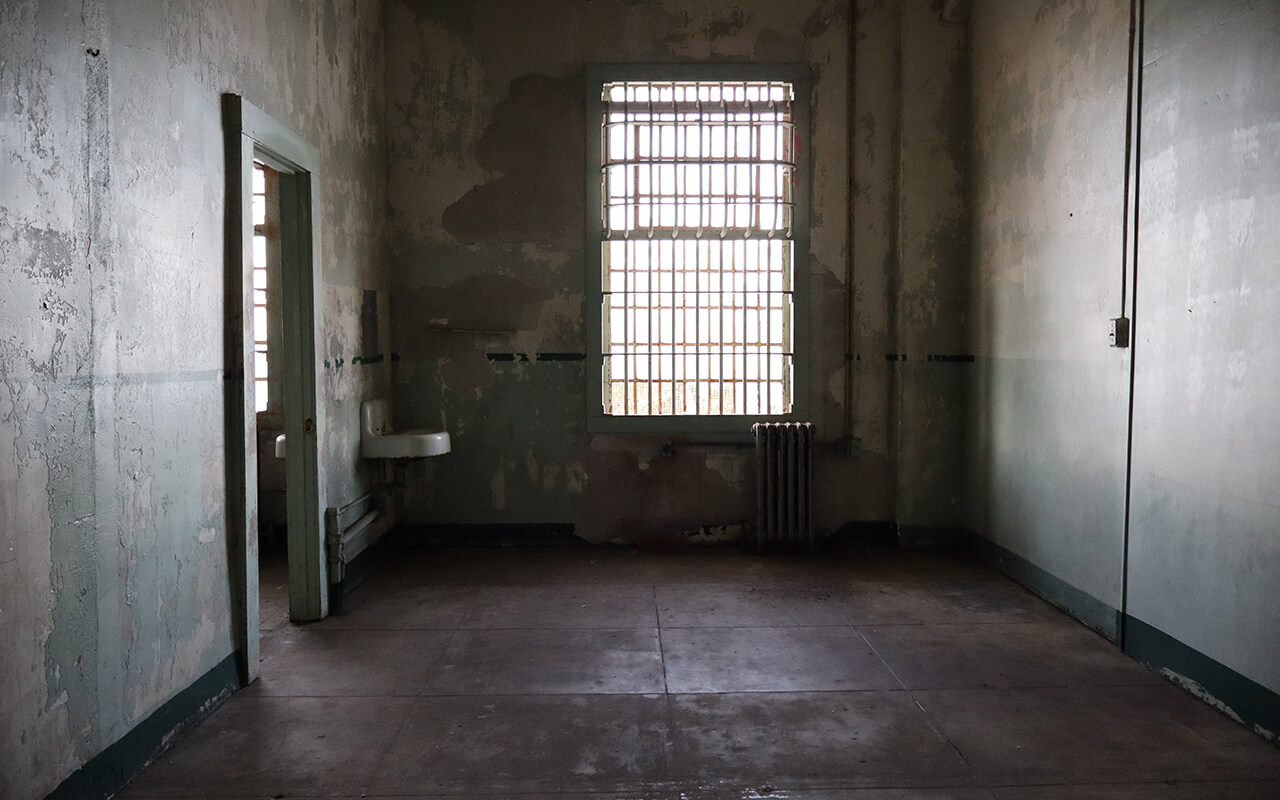
With fewer people around, a peaceful feeling takes over while walking up the quarter-mile hike uphill toward the cellhouse. I took a quick peek at a small, seemingly unassuming building on the way up, which turned out to be the morgue. It was hardly used by the military and used only once during the prison years in Alcatraz — a deceased prisoner’s body was kept there overnight before it could be taken to the mainland. The building was later repurposed to house a backup generator.
With a darkening sky in the background, you step into the massive cellhouse, take your audio narration gear and look at the TV screen that shows a list of live talks and guided tours.
Park officials say these programs — as many as 8-9 per night — are unique to nighttime and are constantly changing based on staff interests. The night I visited, there was a talk about the birds that call the island their home and about banned books not just at Alcatraz but also in prisons across America today.
The guided tours are sometimes held in one spot or they show multiple areas and eventually lead back to the dock. One tour highlights the story of the three prisoners who pulled off the only known escape from Alcatraz in 1962. The guide points out where they climbed down the building, the hillside they scrambled down to get to the water, and where they put a makeshift inflatable raft to escape.
Whether they made it to the mainland alive is still a matter of debate.
One of the reasons that the Night Tour is so popular is the chance to see parts of the cellhouse that are usually closed during the day.
The older part of the prison, known as “A Block ” is occasionally open to night visitors, as well as the prison’s hospital wing. Many visitors relish the spookiness of the hospital. You walk up some stairs, through a dark hallway, and peek into the different rooms including the X-ray room and a room where Robert Stroud, the Birdman of Alcatraz, spent 11 of the 17 years in isolation during his time at the prison.
But heads up, there is planned construction in the hospital wing sometime in 2024-2025 so this area may not be available until that project is complete.
What travelers like about the Night Tour
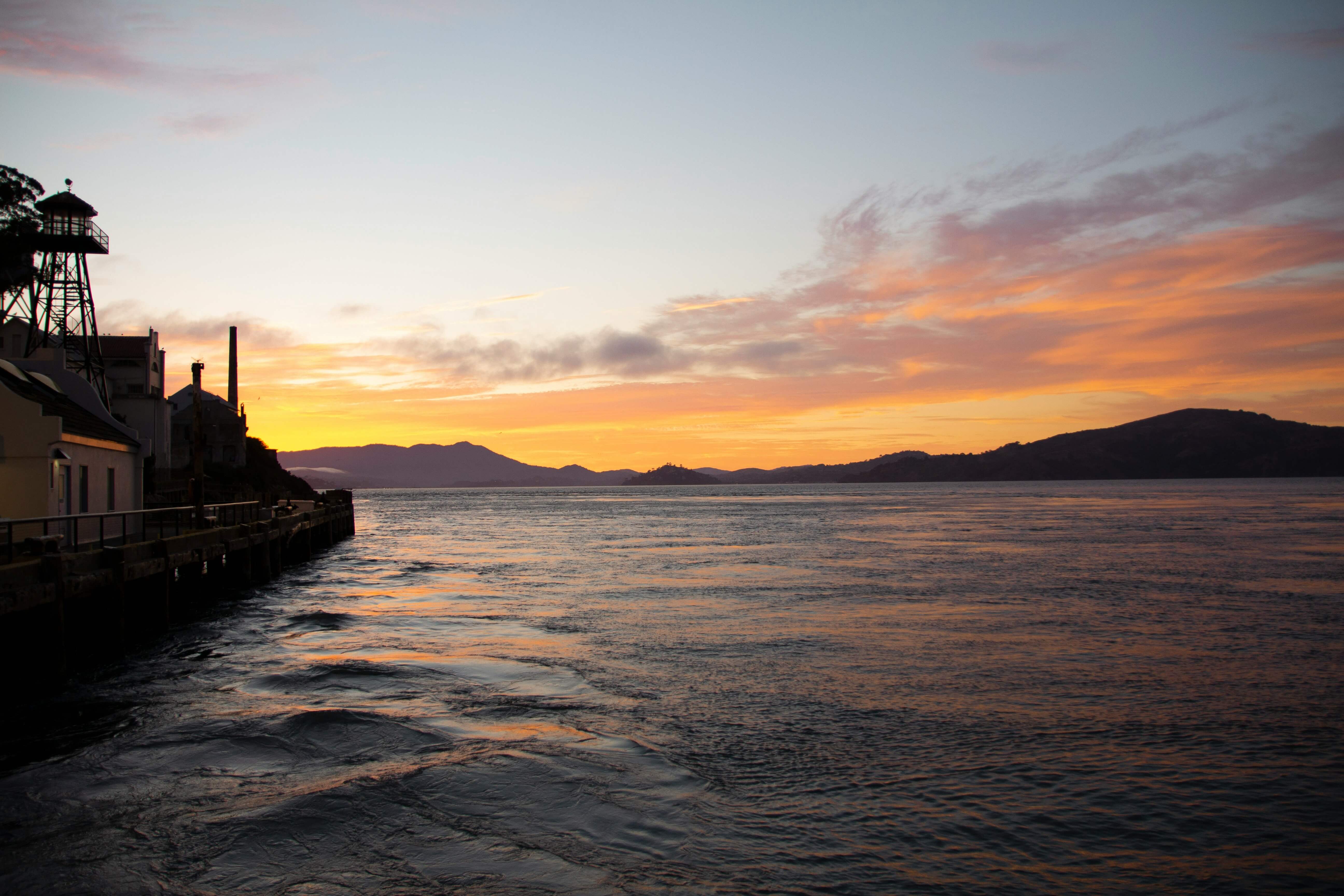
Credit: Julian Kronlachner / sunset from the island on Alcatraz Night Tour
The best part of the night tour is the chance to get a spectacular sunset view from Alcatraz. It’s a unique experience, especially when there’s no fog and the skies are clear, which can be rare in the SF Bay.
Make sure you find a good spot to take in the sight. From the recreation area, you can go down the steep steps into the garden and gaze out toward San Francisco’s skyscape and the outline of the Golden Gate Bridge As the sun slips into the horizon, and the sky turns from light blue to yellow-orange to dark blue and black, the island’s rocky cliffs come alive with squawking birds settling in for the night.
Day or Night Tour: Which one is best for you?

Deciding which tour to take means weighing several things.
The Day Tour is more flexible schedule-wise because there are multiple options for traveling to and from the island — ferry boats leave every 30 minutes. You can also see more things outside of the cellhouse since some buildings are open for a few hours during the day.
It’s also best for families with young kids who want more freedom to run around and not be out too late at night. The Day Tour is a self-guided experience since you’ll use the audio guide in the cellhouse and, if you’d like, the Alcatraz app for the rest of the island.
Our walking tour of Fisherman’s Wharf includes the Day Tour and ferry to Alcatraz. Night Tours can be purchased with Alcatraz City Cruises.
At night, there is more variety with the live talks and guided tours. The focus is not just on history and the sensationalized parts of the prison, but there are also talks reflecting on social justice issues around mass incarceration.
Overall, the Day Tour is ideal for first-time visitors as it gives all of the basics and general historical information. But the Night Tour is perfect for those who have been to Alcatraz before and are looking to see the island from a different perspective. Park officials say the Night Tours are designed for locals or repeat visitors. The dark and minimal lighting creates a spooky atmosphere for touring the cellhouse.
And once you’re done exploring, you can enjoy San Francisco’s twinkling lights while making your way back to Pier 33.
Recap: In general, Day Tours are better for most visitors — and it’s what most visitors choose. But the Night Tour is a must if you want to visit the prison and island after dark.
Tips for your night visit to Alcatraz
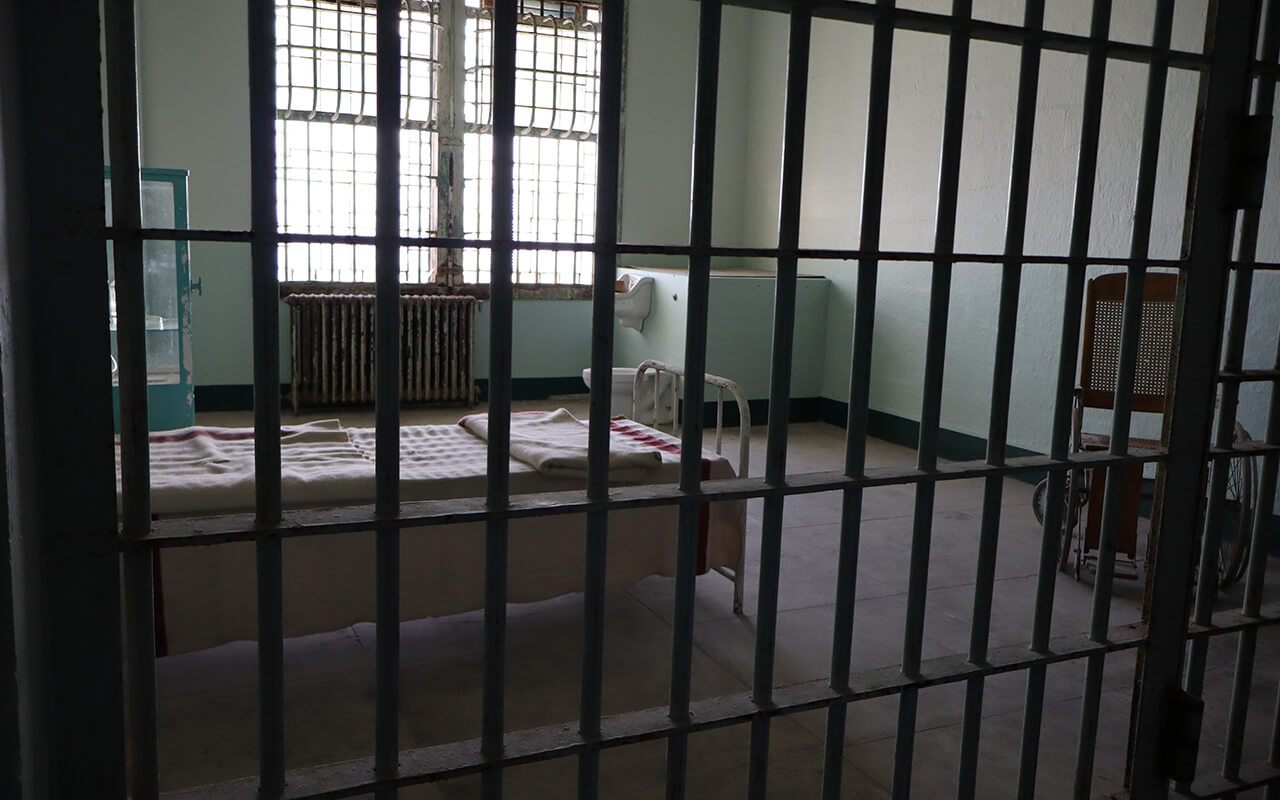
Make sure you are prepared for the cold weather. Even if it’s warm during the day, weather in the Bay can turn on a dime, and you might find yourself freezing if you don’t bring an extra coat. It can get especially windy (and chilly) at night and during the boat ride so make sure to layer up for the ride back to Pier 33.
Watch your step while walking around the cellhouse and also in all of the areas outside of the prison. Some pathways are uneven and you have to watch your step especially when it gets dark.
Watch for signs around the island and don’t go where you’re not supposed to.
Make sure to take a photo of the live talks and guided tour itinerary in the area where you get the audio tour equipment. It’ll help you plan the night accordingly — take note of the meeting times and locations because they are different for the various talks.
Check the time for when the sun will set and make sure you have a good spot to watch. The Alcatraz gardens behind the prison’s recreation area are your best bet.
Most important tip of all: Remember that the boat return times are only every hour at night. Be mindful of when the last boat returns to the mainland. You don’t want to get stuck there. There will be plenty of reminders from park staff to make sure you literally don’t miss the boat.
A reflection on mass incarceration
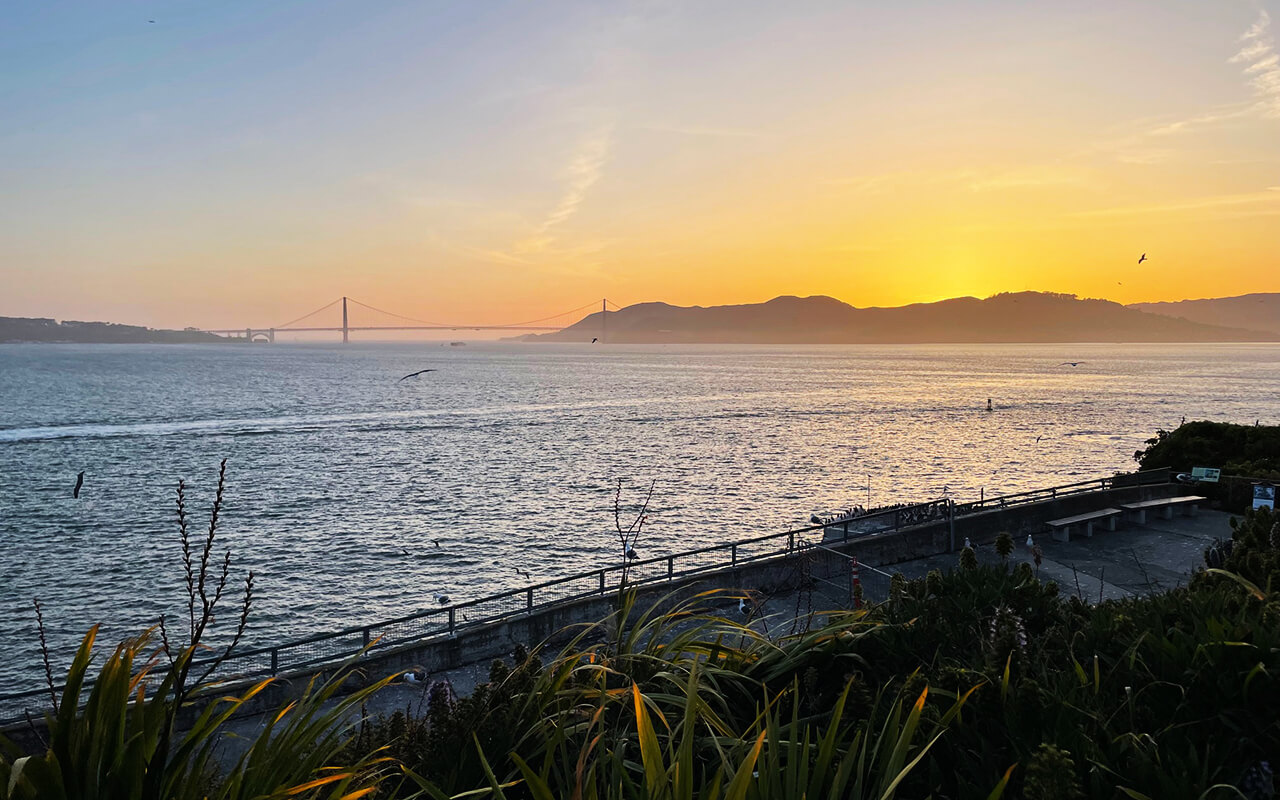
Intrigue and mystique aside, a tour of Alcatraz Island at night is truly a unique experience.
There’s no better time to explore the island’s lush gardens and listen to the various birds of Alcatraz greeting each other as they rest on the rocky hillsides. As the sun sets in the background, you can reflect on the lives of the men who were imprisoned at Alcatraz — deemed to be too disruptive or problematic to be housed in other prisons.
Stories of daring escapes and infamous criminals are what draw most people to this iconic destination. But in recent years, the National Park Service and the Golden Gate National Parks Conservancy have also created an educational experience — challenging visitors to reflect on the fairness of the country’s criminal justice system.
The exhibits, live talks, and guided tours now address deeper questions around mass incarceration: recidivism, rehabilitation, and racial disparities.
Both the Night Tour and Day Tour give you time to reflect on these complex issues, though it’s even more poignant at night with fewer visitors.
But whichever tour you choose, visiting Alcatraz is a must while you’re in San Francisco. We hope to see you here soon!
Everyone should visit Alcatraz at least once. Known as an inescapable fortress, the island served as a federal penitentiary from 1934-1963 and housed some of the country’s most notorious criminals. Today, it’s a National Historic Landmark operated by the National Park Service.
As a San Francisco local, it took me years to make it to The Rock, but since that first visit I’ve been fascinated by its history and have made the trip over and over again.
What is it like exploring the island? How should you plan for your trip and what should you see? I’ll cover all that and more so your first visit can be just as memorable as — or maybe even better than — mine was.
My first visit to Alcatraz
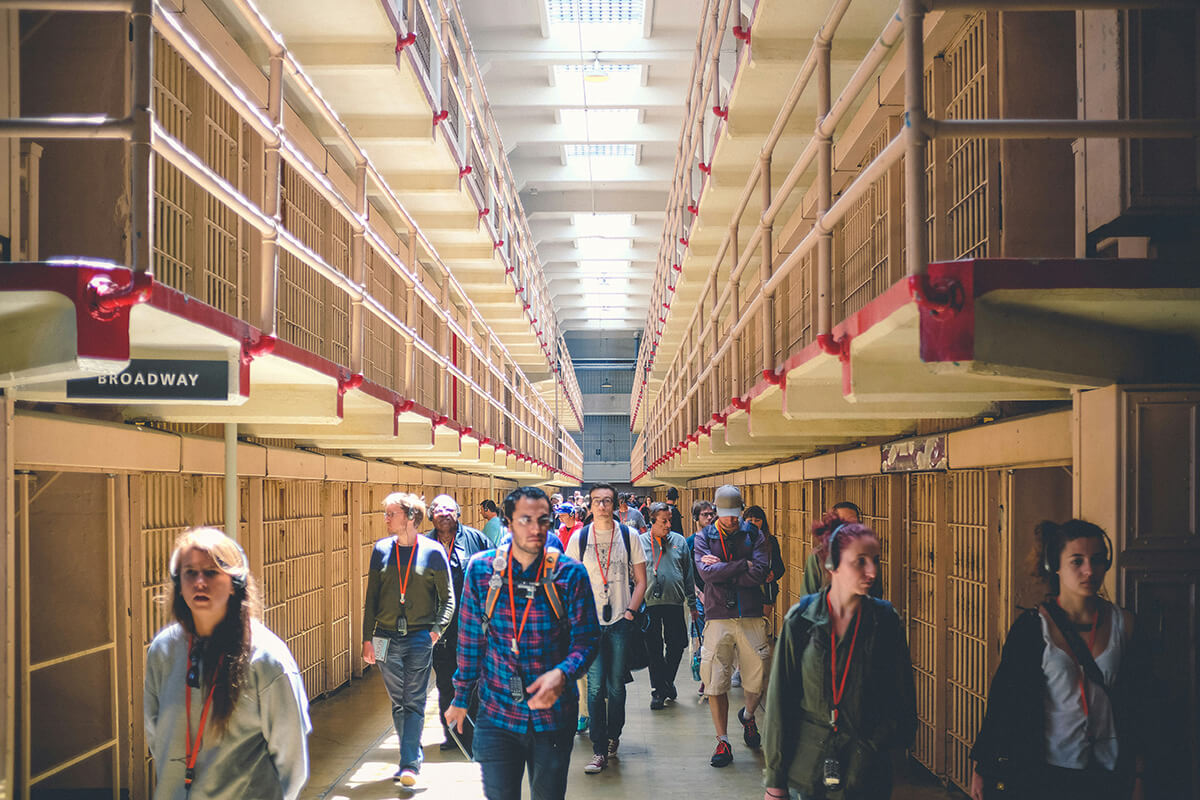
The first time I visited Alcatraz I had already been a San Francisco resident for close to a decade. A friend was visiting the city from North Carolina and arrived on my doorstep armed with tickets for both of us to make the trip.
After a morning at Fisherman’s Wharf and Pier 39 and a particularly hilarious encounter with a seagull near the sea lions (which led to the unexpected loss of an ice cream cone), we boarded the ferry and headed to The Rock for the afternoon.
Hop aboard the ferry
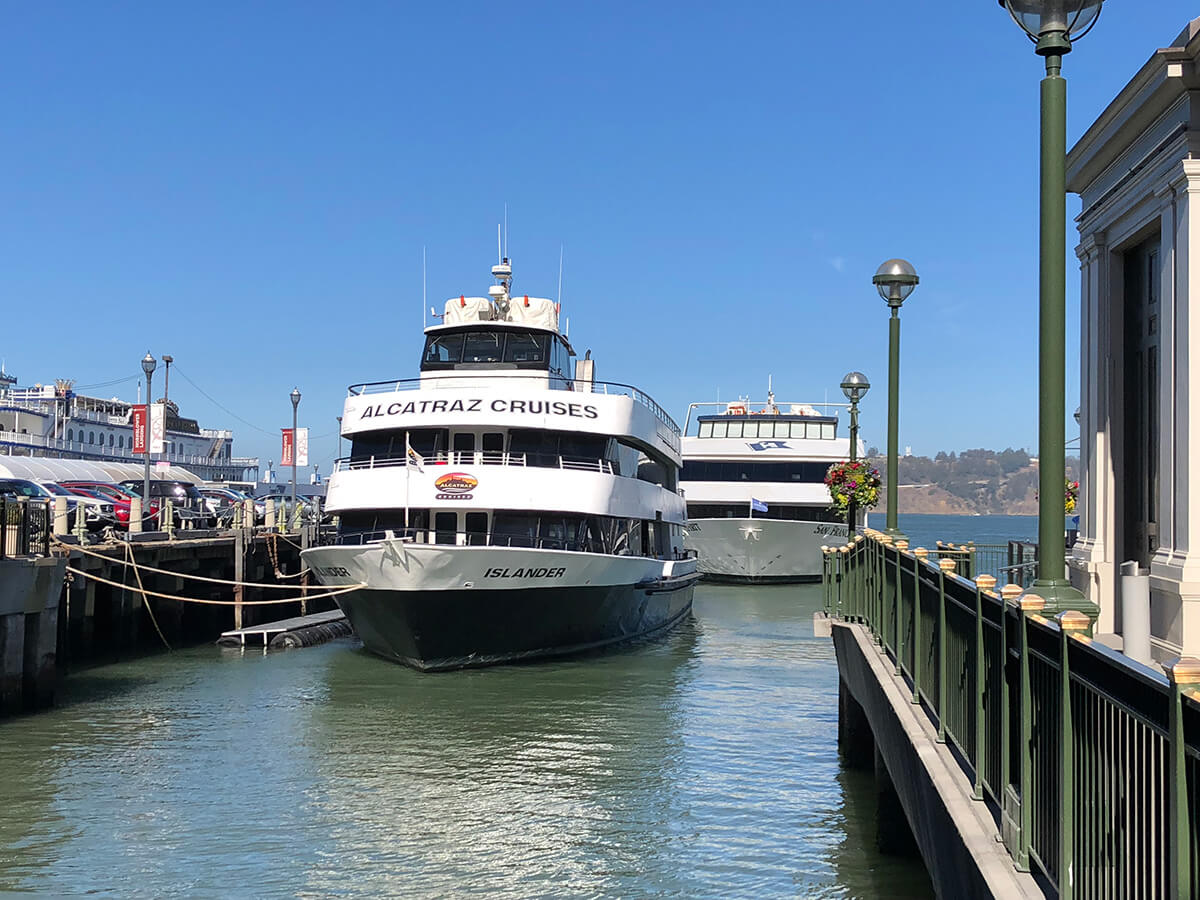
If you haven’t been to San Francisco, and you get lucky enough to take the ferry on a clear day like we did, the views of the city you can catch from the deck are unmatched.
Out on the water, you can get a good look at both the Golden Gate Bridge and Bay Bridge as well as beautiful city skyline views that include iconic spots like Coit Tower and the Transamerica Building during the slow 15-minute ride over to the island.
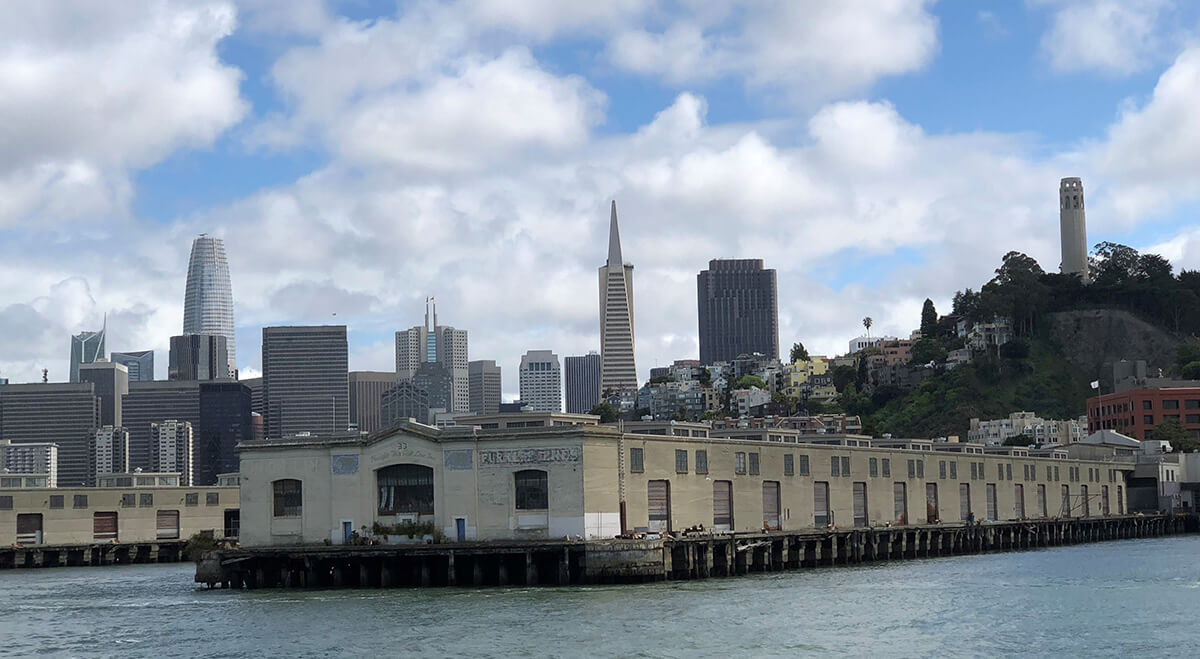
If the weather is nice, you’ll want to snag a seat outside on the deck if you can so you can see everything as you travel and snap a few shots along the way. Even if you can’t score a seat, you’re often able to move around once your journey is underway so you’ll be able to venture out and grab a few shots.
Step inside history
Admittedly, when I went to Alcatraz, I wasn’t exactly sure what to expect. Once you disembark from the ferry and make it inside, the park — Alcatraz is part of the National Parks Service — offers an audio tour option that’s honestly pretty fantastic.
The recording lasts about 30 minutes and goes a bit further than just telling you what you’re looking at and has some more theatrical components with tales from former prisoners and guards that bring the empty jail to life. I’m not typically an audio tour gal, but I’m glad my friend talked me into grabbing a set of headphones for this one.
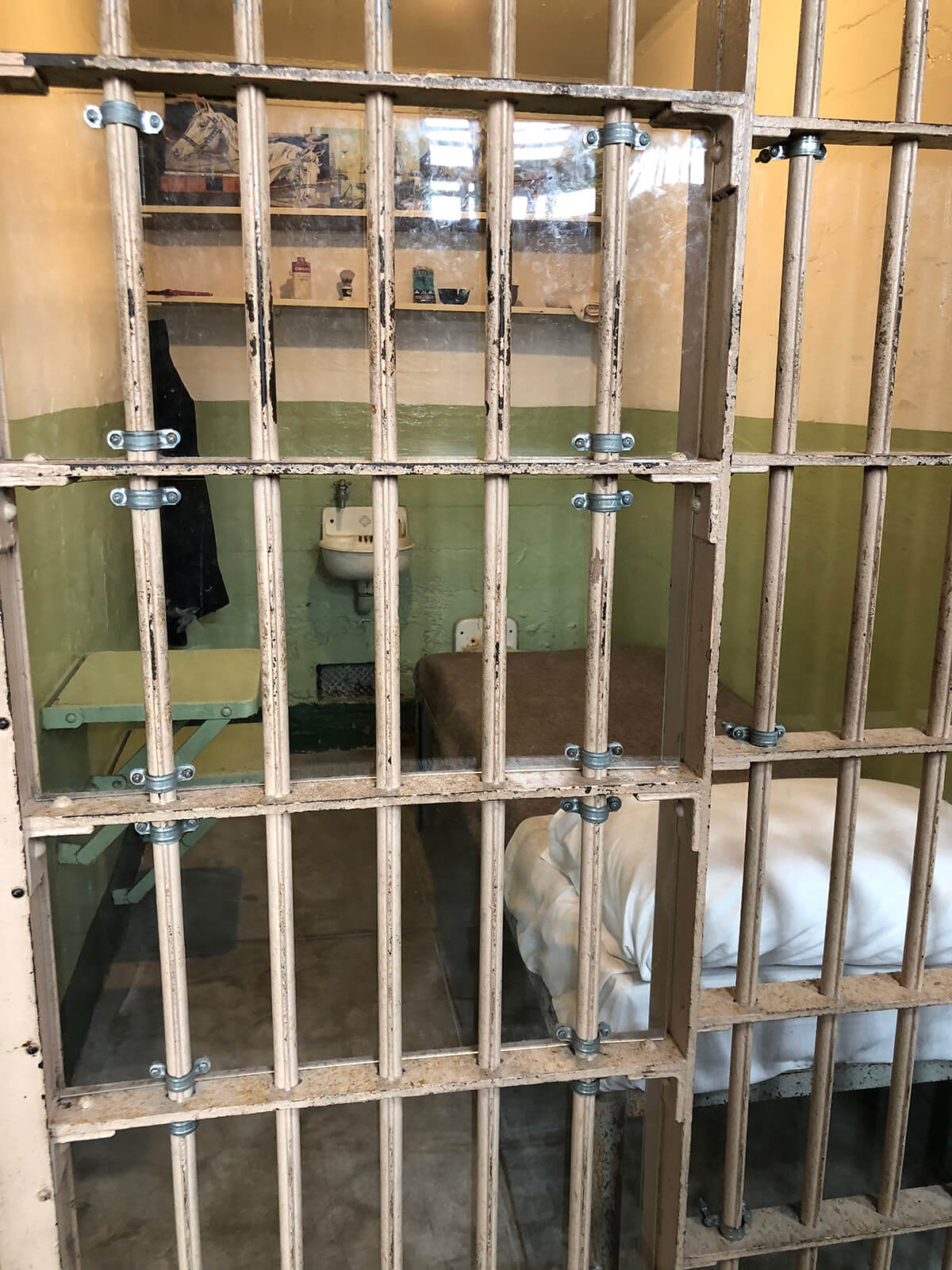
Walking around there are plenty of photo ops and some unintentionally comedic mannequin recreations of a few prisoners that are worth a few pics on their own. The jail housed some pretty epic criminals including Al “Scarface” Capone, Robert “The Birdman” Stroud, and George “Machine Gun” Kelly, and it’s more interesting than you might think to see where they lived during their stay on the island — and think about how some others managed to escape.
How to visit Alcatraz Island
Given where Alcatraz is, the only way to visit is by taking one of the organized ferry rides over from Fisherman’s Wharf, many of which book up far in advance.
Our tour can be a great way to get one of the often hard-to-get tickets on the ferry over to the island. Even better, you’ll head to Alcatraz after exploring sights like Pier 39 and Ghirardelli Square, so you’ll have a better perspective of what you’re looking back at when you do get out on the ocean.
Your tour guide can also offer a glimpse into SF history before you head over, giving you a leg up on other guests who might not know as much about the area before they arrive and helping you get the most out of your visit.
Once you’re there, you can stay on the island as long as you’d like, provided you make it to the last ferry, so take your time and really enjoy looking around. There’s tons to see.
Tips for first-time visitors to Alcatraz
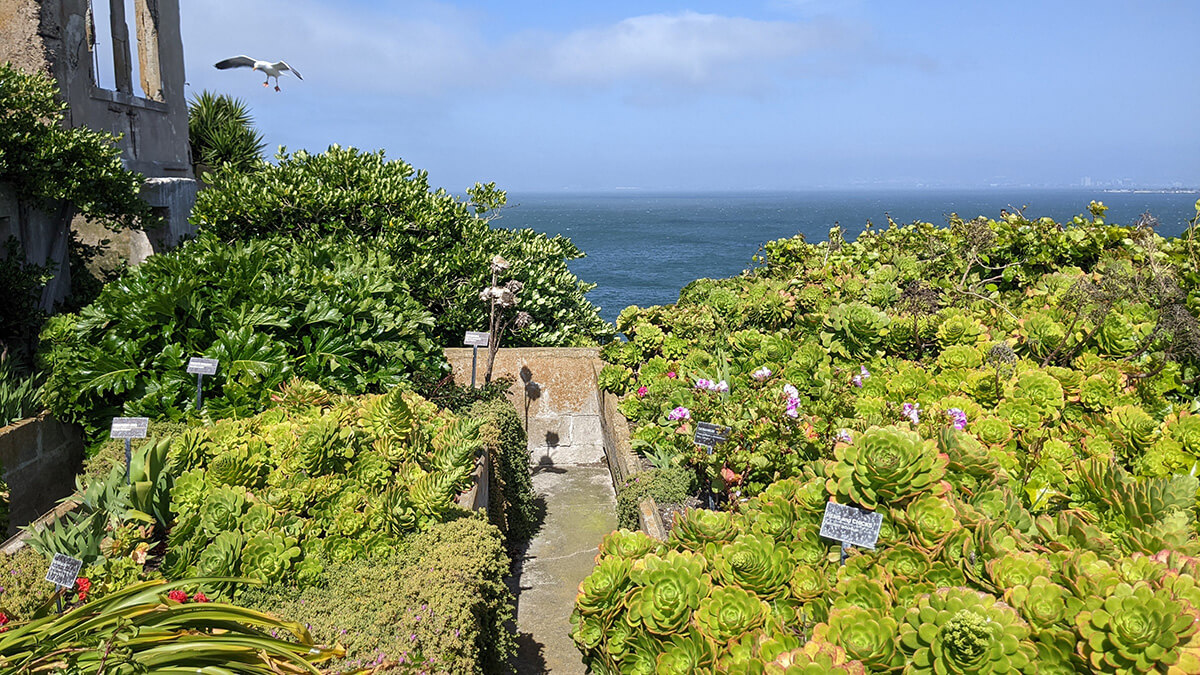
If you’ve never been to Alacatraz before, there are a few things you can do to ensure your trip is a good one. Here are my top tips for visiting The Rock.
- Plan ahead. Alcatraz is a popular place to visit, and there are only so many ferry trips to the island each day. If you know you want to make the trip to the island, then you’ll want to purchase your ticket as soon as you can to make sure you secure a spot. If you book one of our tours, it’s included.
- Dress in layers. Weather in San Francisco, in general, can be a bit unpredictable and vary even from neighborhood to neighborhood. Your ferry ride is likely to be a bit windy, so you’ll want to at least have a jacket on hand. Weather on Alcatraz can fluctuate throughout the day, with colder foggy mornings and afternoons and warmer temperatures in clear weather. Dressing in layers can ensure you’re ready no matter what the day brings.
- Be prepared to walk. The island offers an accessibility tram for those who need it, but most Alcatraz guests will be hiking up an incline to the cellhouse from the ferry dock, a journey that’s roughly a quarter of a mile. You’ll want to wear shows you’re comfortable making that trek in that will also be comfortable while you’re exploring the jail.
- Pack light. You’re going to walk around a ton while you’re on the island, and there’s no place to store extra stuff. Take the time to drop your shopping bags and other large items off at the hotel before you take the tour — you’ll thank yourself later.
- Eat before you go. You can purchase water in the bookstore at Alcatraz, but your options on what to eat and where to eat it are very limited. Eating is prohibited everywhere on the island with the exception of the dock, and only bottled water is allowed while you’re touring the jail, so make sure you grab a meal before you embark from Fisherman’s Wharf.
- Visit the gardens. Don’t miss out on seeing Alcatraz’s historic gardens when you visit. The gardens were planted near the turn of the century when the island was being used as a military fort and can make for a nice addition to your tour of the island, a cheerful contrast to the dark and muted interior of the jail.
- Download the National Parks App. Download the National Park Service Mobile App before your trip for additional insights beyond what you’ll hear on the audio tour through the cellhouse.
An unforgettable experience
Whether it’s your first time experiencing The Rock, or you’ve been a dozen times, there’s always something new to check out at Alcatraz.
While it took me 10 years to make my first trip, I’ve found myself wanting to go back and explore anytime a friend comes to town to visit and having a blast every time I do.
Ready to go? Join one of our Alcatraz tours.